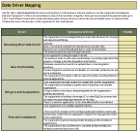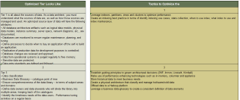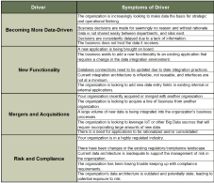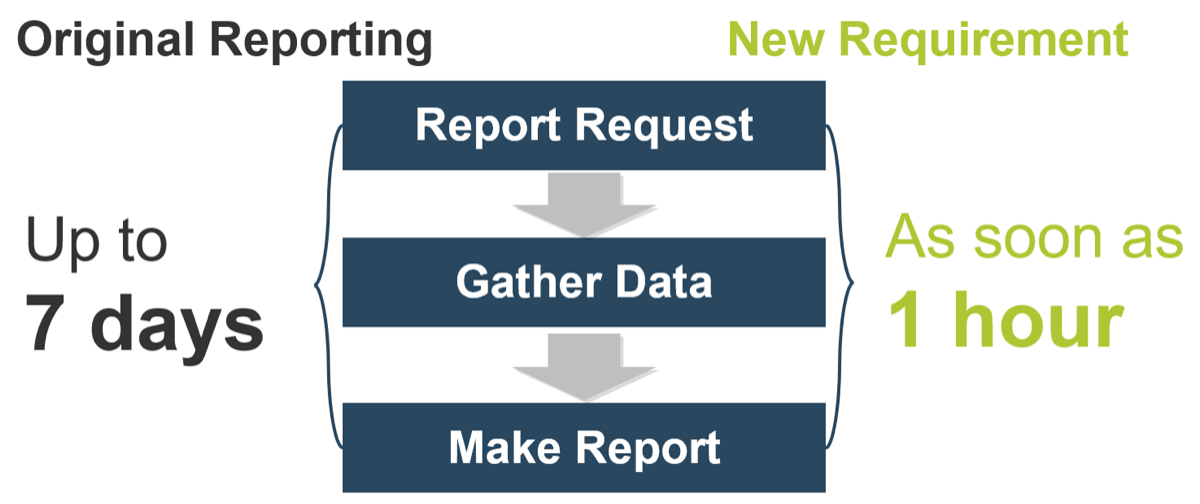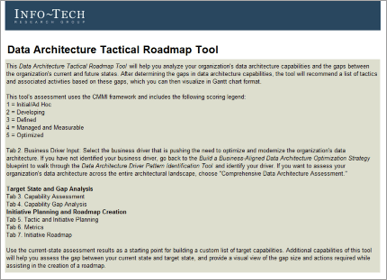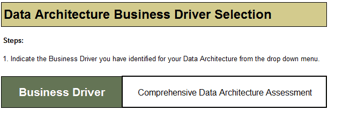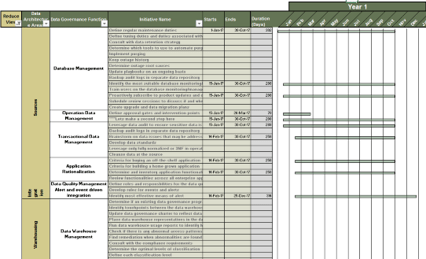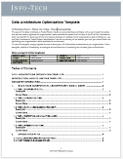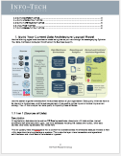Build a Data Architecture Roadmap

- Data architecture involves many moving pieces requiring coordination to provide greatest value from data.
- Data architects are at the center of this turmoil and must be able to translate high-level business requirements into specific instructions for data workers using complex data models.
- Data architects must account for the constantly growing data and application complexity, more demanding needs from the business, an ever-increasing number of data sources, and a growing need to integrate components to ensure that performance isn’t compromised.
Our Advice
Critical Insight
- Data architecture needs to evolve with the changing business landscape. There are four common business drivers that put most pressure on archaic architectures. As a result, the organization’s architecture must be flexible and responsive to changing business needs.
- Data architecture is not just about models. Viewing data architecture as just technical data modeling can lead to structurally unsound data that does not serve the business.
- Data is used differently across the layers of an organization’s data architecture, and the capabilities needed to optimize use of data change with it. Architecting and managing data from source to warehousing to presentation requires different tactics for optimal use.
Impact and Result
- Have a framework in place to identify the appropriate solution for the challenge at hand. Our three-phase practical approach will help you build a custom and modernized data architecture.
- Identify and prioritize the business drivers in which data architecture changes would create the largest overall benefit, and determine the corresponding data architecture tiers that need to be addressed.
- Discover the best-practice trends, measure your current state, and define the targets for your data architecture tactics.
- Build a cohesive and personalized roadmap for restructuring your data architecture. Manage your decisions and resulting changes.
Build a Data Architecture Roadmap Research & Tools
Start here – read the Executive Brief
Read our concise Executive Brief to find out why your organization should optimize its data architecture as it evolves with the drivers of the business to get the most from its data.Besides the small introduction, subscribers and consulting clients within this management domain have access to:
- Build a Data Architecture Roadmap – Phases 1-3
1. Prioritize your data architecture with business-driven tactics
Identify the business drivers that necessitate data architecture improvements, then create a tactical plan for optimization.
- Build a Business-Aligned Data Architecture Optimization Strategy – Phase 1: Prioritize Your Data Architecture With Business-Driven Tactics
- Data Architecture Driver Pattern Identification Tool
- Data Architecture Optimization Template
2. Personalize your tactics to optimize your data architecture
Analyze how you stack up to Info-Tech’s data architecture capability model to uncover your tactical plan, and discover groundbreaking data architecture trends and how you can fit them into your action plan.
- Build a Business-Aligned Data Architecture Optimization Strategy – Phase 2: Personalize Your Tactics to Optimize Your Data Architecture
- Data Architecture Tactical Roadmap Tool
- Data Architecture Trends Presentation
3. Create your tactical data architecture roadmap
Optimize your data architecture by following tactical initiatives and managing the resulting change brought on by those optimization activities.
- Build a Business-Aligned Data Architecture Optimization Strategy – Phase 3: Create Your Tactical Data Architecture Roadmap
- Data Architecture Decision Template
Workshop: Build a Data Architecture Roadmap
Workshops offer an easy way to accelerate your project. If you are unable to do the project yourself, and a Guided Implementation isn't enough, we offer low-cost delivery of our project workshops. We take you through every phase of your project and ensure that you have a roadmap in place to complete your project successfully.
1 Identify the Drivers of the Business for Optimizing Data Architecture
The Purpose
Explain approach and value proposition.
Review the common business drivers and how the organization is driving a need to optimize data architecture.
Understand Info-Tech’s five-tier data architecture model.
Determine the pattern of tactics that apply to the organization for optimization.
Key Benefits Achieved
Understanding of the current data architecture landscape.
Priorities for tactical initiatives in the data architecture practice are identified.
Target state for the data quality practice is defined.
Activities
1.1 Explain approach and value proposition.
1.2 Review the common business drivers and how the organization is driving a need to optimize data architecture.
1.3 Understand Info-Tech’s five-tier data architecture model.
1.4 Determine the pattern of tactics that apply to the organization for optimization.
Outputs
Five-tier logical data architecture model
Data architecture tactic plan
2 Determine Your Tactics For Optimizing Data Architecture
The Purpose
Define improvement initiatives.
Define a data architecture improvement strategy and roadmap.
Key Benefits Achieved
Gaps, inefficiencies, and opportunities in the data architecture practice are identified.
Activities
2.1 Create business unit prioritization roadmap.
2.2 Develop subject area project scope.
2.3 Subject area 1: data lineage analysis, root cause analysis, impact assessment, business analysis
Outputs
Business unit prioritization roadmap
Subject area scope
Data lineage diagram
3 Create a Strategy for Data Quality Project 2
The Purpose
Define improvement initiatives.
Define a data quality improvement strategy and roadmap.
Key Benefits Achieved
Improvement initiatives are defined.
Improvement initiatives are evaluated and prioritized to develop an improvement strategy.
A roadmap is defined to depict when and how to tackle the improvement initiatives.
Activities
3.1 Create business unit prioritization roadmap.
3.2 Develop subject area project scope.
3.3 Subject area 1: data lineage analysis, root cause analysis, impact assessment, business analysis.
Outputs
Business unit prioritization roadmap
Subject area scope
Data lineage diagram
Further reading
Build a Data Architecture Roadmap
Optimizing data architecture requires a plan, not just a data model.
ANALYST PERSPECTIVE
Integral to an insight-driven enterprise is a modern and business-driven data environment.
“As business and data landscapes change, an organization’s data architecture needs to be able to keep pace with these changes. It needs to be responsive so as to not only ensure the organization continues to operate efficiently but that it supports the overall strategic direction of the organization.
In the dynamic marketplace of today, organizations are constantly juggling disruptive forces and are finding the need to be more proactive rather than reactive. As such, organizations are finding their data to be a source of competitive advantage where the data architecture has to be able to not only support the increasing amount, sources, and rate at which organizations are capturing and collecting data but also be able to meet and deliver on changing business needs.
Data architecture optimization should, therefore, aid in breaking down data silos and creating a more shared and all-encompassing data environment for better empowering the business.” (Crystal Singh, Director, Research, Data and Information Practice, Info-Tech Research Group)
Our understanding of the problem
This Research Is Designed For:
|
This Research Will Help You:
|
This Research Will Also Assist:
|
This Research Will Help Them:
|
Executive summary
Situation
- The data architecture of a modern organization involves many moving pieces requiring coordination to provide greatest value from data.
- Data architects are at the center of this turmoil and must be able to translate high-level business requirements into specific instructions for data workers using complex data models.
Complication
- Data architects must account for the constantly growing data and application complexity, and more demanding needs from the business.
- There is an ever-increasing number of data sources and a growing need to integrate components to ensure that performance isn’t compromised.
- There isn’t always a clearly defined data architect role, yet the responsibilities must be filled to get maximum value from data.
Resolution
- To deal with these challenges, a data architect must have a framework in place to identify the appropriate solution for the challenge at hand.
- Identify and prioritize the business drivers in which data architecture changes would create the largest overall benefit, and determine the corresponding data architecture tiers that need to be addressed to customize your solution.
- Discover the best practice trends, measure your current state, and define the targets for your data architecture tactics.
- Build a cohesive and personalized roadmap for restructuring your data architecture. Manage your decisions and resulting changes.
Info-Tech Insight
- Data architecture is not just about models. Viewing data architecture as just technical data modeling can lead to a data environment that does not aptly serve or support the business. Identify the priorities of your business and adapt your data architecture to those needs.
- Changes to data architecture are typically driven by four common business driver patterns. Use these as a shortcut to understand how to evolve your data architecture.
- Data is used differently across the layers of an organization’s data architecture; therefore, the capabilities needed to optimize the use of data change with it. Architecting and managing data from source to warehousing to presentation requires different tactics for optimal use.
Your data is the foundation of your organization’s knowledge and ability to make decisions
Data should be at the foundation of your organization’s evolution.
The transformational insights that executives are constantly seeking to leverage can be uncovered with a data practice that makes high quality, trustworthy information readily available to the business users who need it.
50% Organizations that embrace data are 50% more likely to launch products and services ahead of their competitors. (Nesta, 2016)
Whether hoping to gain a better understanding of your business or trying to become an innovator in your industry, any organization can get value from its data regardless of where you are in your journey to becoming a data-driven enterprise:
Business Monitoring
|
Business Insights
|
Business Optimization
|
Business Transformation
|
As organizations seek to become more data driven, it is imperative to better manage data for its effective use
Here comes the zettabyte era.
A zettabyte is a billion terabytes. Organizations today need to measure their data size in zettabytes, a challenge that is only compounded by the speed at which the data is expected to move.
Arriving at the understanding that data can be the driving force of your organization is just the first step. The reality is that the true hurdles to overcome are in facing the challenges of today’s data landscape.
| Challenges of The Modern Data Landscape | ||||
| Data at rest | Data movement | |||
| Greater amounts | Different types | Uncertain quality | Faster rates | Higher complexity |
“The data environment is very chaotic nowadays. Legacy applications, data sprawl – organizations are grappling with what their data landscape looks like. Where are our data assets that we need to use?” (Andrew Johnston, Independent Consultant)
Solution
Well-defined and structured data management practices are the best way to mitigate the limitations that derive from these challenges and leverage the most possible value from your data.
Refer to Info-Tech’s capstone Create a Plan For Establishing a Business-Aligned Data Management Practice blueprint to understand data quality in the context of data disciplines and methods for improving your data management capabilities.
Data architecture is an integral aspect of data management
Data ArchitectureThe set of rules, policies, standards, and models that govern and define the type of data collected and how it is used, stored, managed, and integrated within the organization and its database systems. In general, the primary objective of data architecture is the standardization of data for the benefit of the organization. 54% of leading “analytics-driven” enterprises site data architecture as a required skill for data analytics initiatives. (Maynard 2015) |
MYTHData architecture is purely a model of the technical requirements of your data systems. REALITYData architecture is largely dependent on a human element. It can be viewed as “the bridge between defining strategy and its implementation”. (Erwin 2016) |
FunctionsA strong data architecture should:
|
Business valueA strong data architecture will help you:
|
Data architects must maintain a comprehensive view of the organization’s rapidly proliferating data
The data architect:
|
Data architects bridge the gap between strategic and technical requirements: 
“Fundamentally, the role of a data architect is to understand the data in an organization at a reasonable level of abstraction.” (Andrew Johnston, Independent Consultant) |
Many are experiencing the pains of poor data architecture, but leading organizations are proactively tackling these issues
Outdated and archaic systems and processes limit the ability to access data in a timely and efficient manner, ultimately diminishing the value your data should bring.
59% |
of firms believe their legacy storage systems require too much processing to meet today’s business needs. (Attivio, Survey Big Data decision Makers, 2016) | 48% |
of companies experience pains from being reliant on “manual methods and trial and error when preparing data.” (Attivio, Survey Big Data decision Makers, 2016) | 44% |
44% of firms said preparing data was their top hurdle for analytics, with 22% citing problems in accessing data. (Data Virtualization blog, Data Movement Killed the BI Star, 2016) |
Intuitive organizations who have recognized these shortcomings have already begun the transition to modernized and optimized systems and processes.
28% |
of survey respondents say they plan to replace “data management and architecture because it cannot handle the requirements of big data.” (Informatica, Digital Transformation: Is Your Data Management Ready, 2016) | 50% |
Of enterprises plan to replace their data warehouse systems and analytical tools in the next few years. (TDWI, End of the Data Warehouse as we know it, 2017) |
Leading organizations are attacking data architecture problems … you will be left behind if you do not start now!
Once on your path to redesigning your data architecture, neglecting the strategic elements may leave you ineffective
Focusing on only data models without the required data architecture guidance can cause harmful symptoms in your IT department, which will lead to organization-wide problems.
| IT Symptoms Due to Ineffective Data Architecture | ||
Poor Data Quality
|
Poor Accessibility
|
Strategic Disconnect
|
| Leads to Poor Organizational Conditions | ||
Inaccurate Insights
|
Ineffective Decision Making
|
Inefficient Operations
|
| You need a solution that will prevent the pains. | ||
Follow Info-Tech’s methodology to optimize data architecture to meet the business needs
The following is a summary of Info-Tech’s methodology:
1 |
|
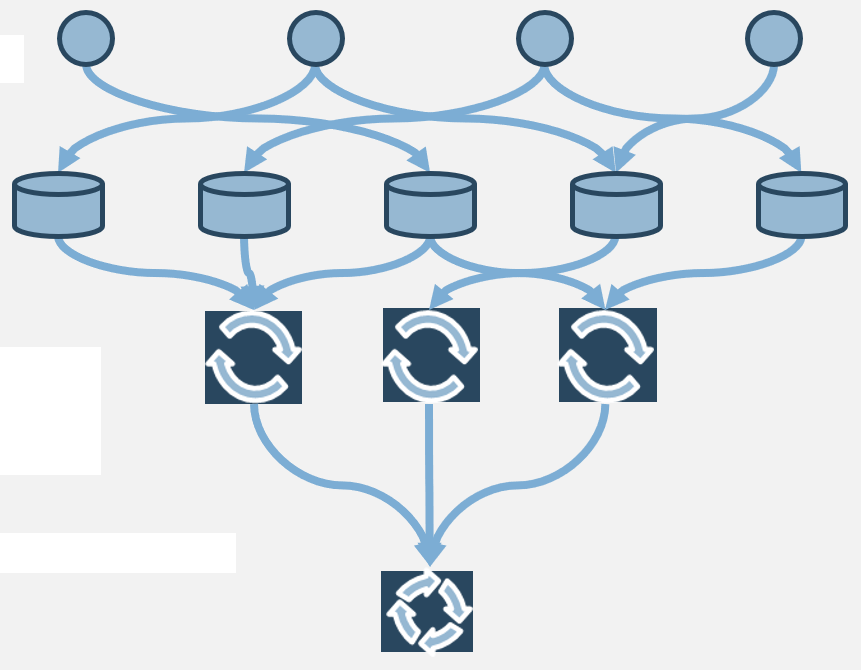 |
2 |
|
|
3 |
|
 |
Info-Tech will get you to your optimized state faster by focusing on the important business issues
First Things First
- Info-Tech’s methodology helps you to prioritize and establish the core strategic objectives behind your goal of modernizing data architecture. This will narrow your focus to the appropriate areas of your current data systems and processes that require the most attention.
Info-Tech has identified these four common drivers that lead to the need to optimize your data architecture.
- Becoming More Data Driven
- Regulations and Compliance
- Mergers and Acquisitions
- New Functionality or Business Rule
These different core objectives underline the motivation to optimize data architecture, and will determine your overall approach.
Use the five-tier architecture to provide a consumable view of your data architecture
Every organization’s data system requires a unique design and an assortment of applications and storage units to fit their business needs. Therefore, it is difficult to paint a picture of an ideal model that has universal applications. However, when data architecture is broken down in terms of layers or tiers, there exists a general structure that is seen in all data systems.
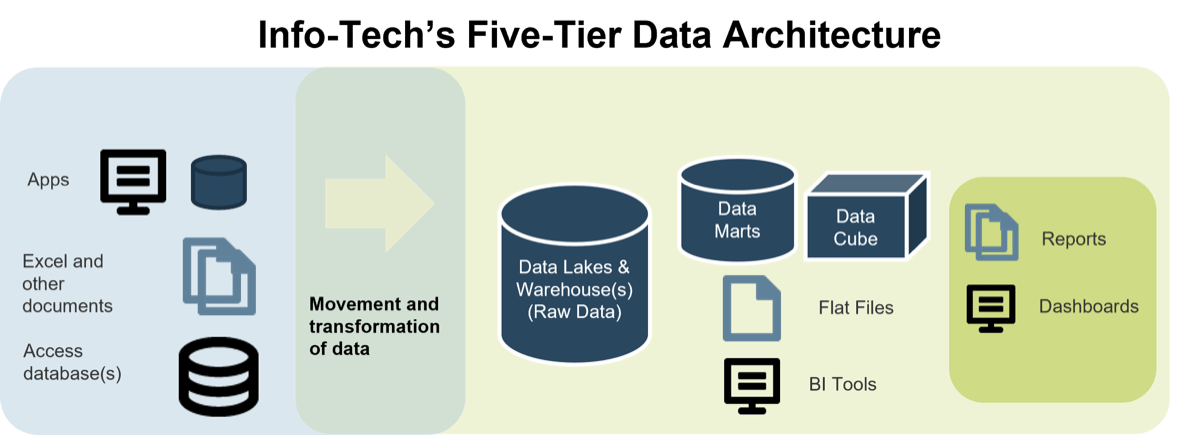
Thinking of your data systems and processes in this framework will allow you to see how different elements of the architecture relate to specific business operations.
|
|
Use the five-tier architecture to prioritize tactics to improve your data architecture in line with your pattern
Info-Tech’s Data Architecture Capability Model
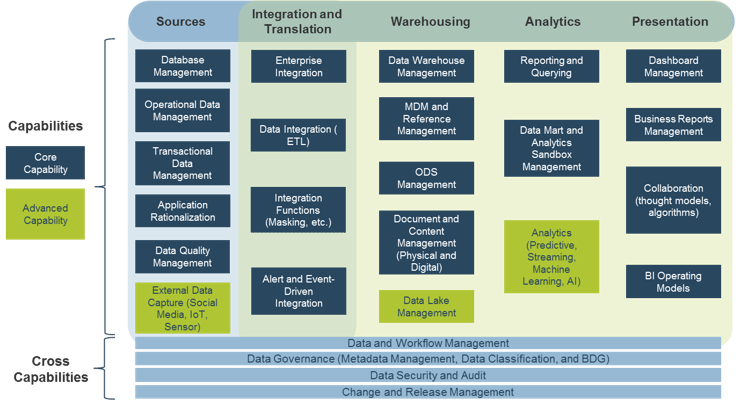 |
|
|
Info-Tech Insight
Optimizing data architecture requires a tactical approach, not a passive approach. The demanding task of optimization requires the ability to heavily prioritize. After you have identified why, determine how using our pre-built roadmap to address the four common drivers. |
Do not forget: data architecture is not a standalone concept; it fits into the more holistic design of enterprise architecture
| Data Architecture in Alignment
Data architecture can not be designed to simply address the focus of data specialists or even the IT department. It must act as a key component in the all encompassing enterprise architecture and reflect the strategy and design of the entire business. Data architecture collaborates with application architecture in the delivery of effective information systems, and informs technology architecture on data related infrastructure requirements/considerations Please refer to the following blueprints to see the full picture of enterprise architecture: |
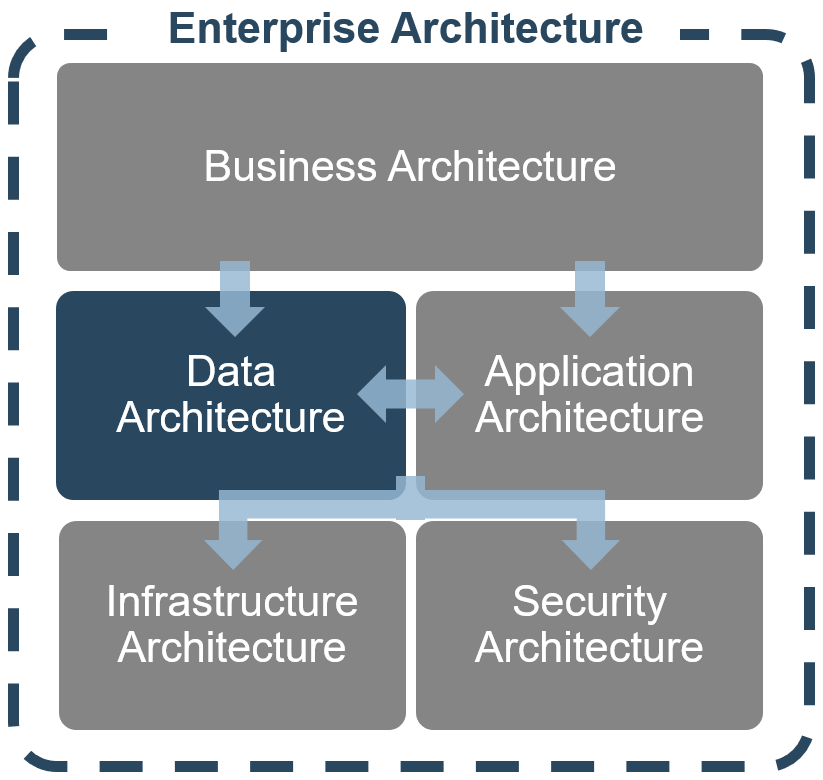
Adapted from TOGAF Refer to Phase C of TOGAF and Bizbok for references to the components of business architecture that are used in data architecture. |
Info-Tech’s data architecture optimization methodology helped a monetary authority fulfill strict regulatory pressures
CASE STUDY |
Industry: Financial
|
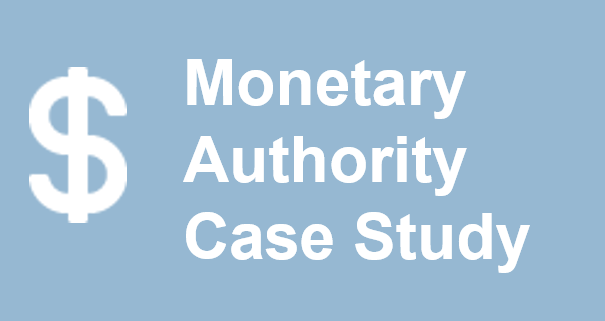 |
Look for this symbol as you walk through the blueprint for details on how Info-Tech Consulting assisted this monetary authority. |
Situation: Strong external pressures required the monetary authority to update and optimize its data architecture.
The monetary authority is responsible for oversight of the financial situation of a country that takes in revenue from foreign incorporation. Due to increased pressure from international regulatory bodies, the monetary authority became responsible for generating multiple different types of beneficial ownership reports based on corporation ownership data within 24 hours of a request.
A stale and inefficient data architecture prevented the monetary authority from fulfilling external pressures.
Normally, the process to generate and provide beneficial ownership reports took a week or more. This was due to multiple points of stale data architecture, including a dependence on outdated legacy systems and a broken process for gathering the required data from a mix of paper and electronic sources.
Provide a structured approach to solving the problem
Info-Tech helped the monetary authority identify the business need that resulted from regulatory pressures, the challenges that needed to be overcome, and actionable tactics for addressing the needs.
Info-Tech’s methodology was followed to optimize the areas of data architecture that address the business driver.
- External Requirements
- Business Driver
- Diagnose Data Architecture Problems
- Outdated architecture (paper, legacy systems)
- Stale data from other agencies
- Incomplete data
- Data Architecture Optimization Tactics
- Optimized Source Databases
- Improved Integration
- Data Warehouse Optimization
- Data Marts for Reports
- Report Delivery Efficiency
As you walk through this blueprint, watch for additional case studies that walk through the details of how Info-Tech helped this monetary authority.
This blueprint’s three-step process will help you optimize data architecture in your organization
Phase 1
Prioritize Your Data Architecture With Business-Driven Tactics |
Phase 2
Personalize Your Tactics to Optimize Your Data Architecture |
Phase 3
Create Your Tactical Data Architecture Roadmap |
Step 1: Identify Your Business Driver for Optimizing Data Architecture
Data Architecture Driver Pattern Identification Tool
Data Architecture Optimization Template |
Step 1: Measure Your Data Architecture Capabilities
Data Architecture Tactical Roadmap Tool
Data Architecture Tactical Roadmap Tool
Data Architecture Trends Presentation |
Step 1: Personalize Your Data Architecture Roadmap
Data Architecture Tactical Roadmap Tool
Data Architecture Decision Template |
Use these icons to help direct you as you navigate this research
Use these icons to help guide you through each step of the blueprint and direct you to content related to the recommended activities.

This icon denotes a slide where a supporting Info-Tech tool or template will help you perform the activity or step associated with the slide. Refer to the supporting tool or template to get the best results and proceed to the next step of the project.

This icon denotes a slide with an associated activity. The activity can be performed either as part of your project or with the support of Info-Tech team members, who will come onsite to facilitate a workshop for your organization.
Info-Tech offers various levels of support to best suit your needs
DIY Toolkit |
Guided Implementation |
Workshop |
Consulting |
| "Our team has already made this critical project a priority, and we have the time and capability, but some guidance along the way would be helpful." | "Our team knows that we need to fix a process, but we need assistance to determine where to focus. Some check-ins along the way would help keep us on track." | "We need to hit the ground running and get this project kicked off immediately. Our team has the ability to take this over once we get a framework and strategy in place." | "Our team does not have the time or the knowledge to take this project on. We need assistance through the entirety of this project." |
Diagnostics and consistent frameworks used throughout all four options
Build a Business-Aligned Data Architecture Optimization Strategy – project overview
| PHASE 1 Prioritize Your Data Architecture With Business-Driven Tactics |
PHASE 2 Personalize Your Tactics to Optimize Your Data Architecture |
PHASE 3 Create Your Tactical Data Architecture Roadmap |
|
 Best-Practice Toolkit |
1.1 Identify Your Business Driver for Optimizing Data Architecture 1.2 Determine Actionable Tactics to Optimize Data Architecture |
2.1 Measure Your Data Architecture Capabilities 2.2 Set a Target for Data Architecture Capabilities 2.3 Identify the Tactics that Apply to Your Organization |
3.1 Personalize Your Data Architecture Roadmap 3.2 Manage Your Data Architecture Decisions and the Resulting Changes |
Guided Implementations |
|
|
|
 Onsite Workshop |
Module 1:
Identify the Drivers of the Business for Optimizing Data Architecture |
Module 2:
Create a Tactical Plan for Optimizing Data Architecture |
Module 3:
Create a Personalized Roadmap for Data Architecture Activities |
Workshop overview
Contact your account representative or email Workshops@InfoTech.com for more information.
Preparation |
Workshop Day 1 |
Workshop Day 2 |
Workshop Day 3 |
Workshop Day 4 |
Workshop Day 5 |
|
| Organize and Plan Workshop | Identify the Drivers of the Business for Optimizing Data Architecture | Determine the Tactics For Optimizing Data Architecture | Create Your Roadmap of Optimization Activities | Create Your Personalized Roadmap | Create a Plan for Change Management | |
Morning Activities |
|
|
|
|
|
|
Afternoon Activities |
|
|
|
|
|
|
Deliverables |
|
|
|
|
|
|
Build a Business-Aligned Data Architecture Optimization Strategy
PHASE 1
Prioritize Your Data Architecture With Business-Driven Tactics
Phase 1 outline
Complete these steps on your own, or call us to complete a guided implementation. A guided implementation is a series of 2-3 advisory calls that help you execute each phase of a project. They are included in most advisory memberships.
Guided Implementation 1: Prioritize Your Data Architecture With Business-Driven Tactics
Proposed Time to Completion: 2 weeks
| Step 1.1: Identify Your Business Driver for Optimizing Data Architecture | Step 1.2: Determine Actionable Tactics to Optimize Data Architecture |
Start with an analyst kick-off call:
|
Review findings with analyst:
|
Then complete these activities…
|
Then complete these activities…
|
With these tools & templates:
|
With these tools & templates:
|
Phase 1 Results & Insights
|
|
Phase 1 will help you create a strategy to optimize your data architecture using actionable tactics
In this phase, you will determine your focus for optimizing your data architecture based on the business drivers that are commonly felt by most organizations.
- Identify the business drivers that necessitate data architecture optimization efforts.
- Understand Info-Tech’s Five-Tier Data Architecture, a logical architecture model that will help you prioritize tactics for optimizing your data architecture environment.
- Identify tactics for optimizing the organization’s data architecture across the five tiers.
“To stay competitive, we need to become more data-driven. Compliance pressures are becoming more demanding. We need to add a new functionality.”
Info-Tech’s Five-Tier Data Architecture:
- Data Sources
- Data Integration and Translation
- Data Warehousing
- Data Analytics
- Data Presentation
Tactical plan for Data Architecture Optimization
Phase 1, Step 1: Identify Your Business Driver for Optimizing Data Architecture
PHASE 1 |
|
| 1.1 | 1.2 |
| Identify Your Business Driver for Optimizing Data Architecture | Determine Actionable Tactics to Optimize Data Architecture |
This step will walk you through the following activities:
- Understand how data architecture fits into the organization’s larger enterprise architecture.
- Understand what data architecture is and how it should be driven by the business.
- Identify the driver that is creating a need for data architecture optimization.
This step involves the following participants:
- Data Architect
- Enterprise Architect
Outcomes of this step
- A starting point for the many responsibilities of the data architect role. Balancing business and technical requirements can be challenging, and to do so you need to first understand what is driving the need for data architecture improvements.
- Holistic understanding of the organization’s architecture environment, including enterprise, application, data, and technology architectures and how they interact.
Data architecture involves planning, communication, and understanding of technology
Data Architecture
A description of the structure and interaction of the enterprise’s major types and sources of data, logical data assets, physical data assets, and data management resources (TOGAF 9).
The subject area of data management that defines the data needs of the enterprise and designs the master blueprints to meet those needs (DAMA DMBOK, 2009).
IBM (2007) defines data architecture as the design of systems and applications that facilitate data availability and distribution across the enterprise.
Definitions vary slightly across major architecture and management frameworks.
However, there is a general consensus that data architecture provides organizations with:
- Alignment
- Planning
- Road mapping
- Change management
- A guide for the organization’s data management program
Data architecture must be based on business goals and objectives; developed within the technical strategies, constraints, and opportunities of the organization in support of providing a foundation for data management.
| Current Data Management |
|
Goal for Data Management |
Info-Tech Insight
Data Architecture is not just data models. Data architects must understand the needs of the business, as well as the existing people and processes that already exist in the organization to effectively perform their job.
Review how data architecture fits into the broader architectural context
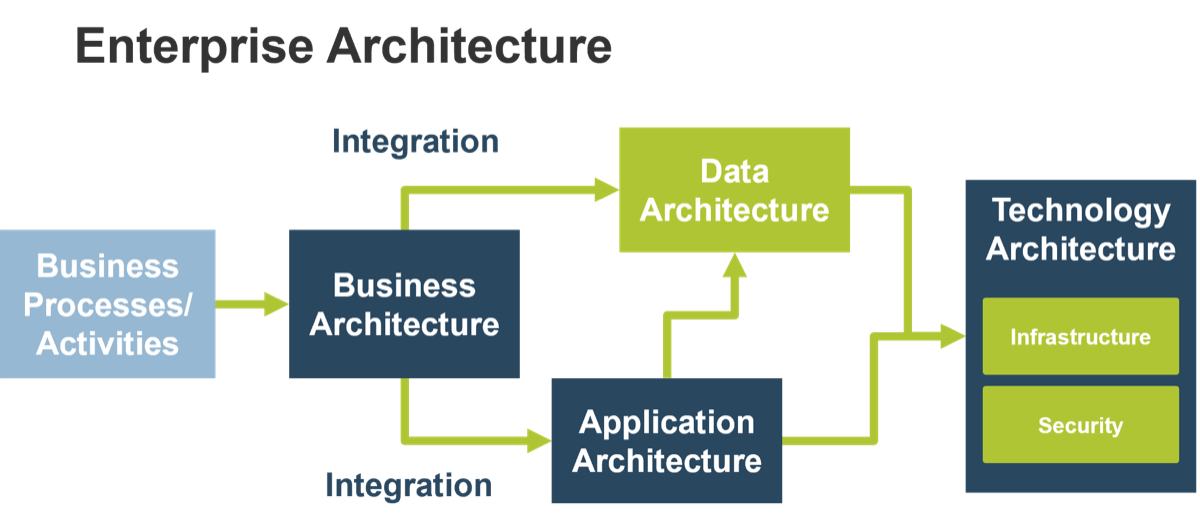 |
Each layer of architecture informs the next. In other words, each layer has components that execute processes and offer services to the next layer. For example, data architecture can be broken down into more granular activities and processes that inform how the organization’s technology architecture should be arranged. |
|
Data does not exist on its own. It is informed by business architecture and used by other architectural domains to deliver systems, IT services, and to support business processes. As you build your practice, you must consider how data fits within the broader architectural framework. |
The Zachman Framework is a widely used EA framework; within it, data is identified as the first domain. The framework aims to standardize artifacts (work-products) within each architectural domain, provides a cohesive view of the scope of EA and clearly delineates data components. Use the framework to ensure that your target DA practice is aligned to other domains within the EA framework. |
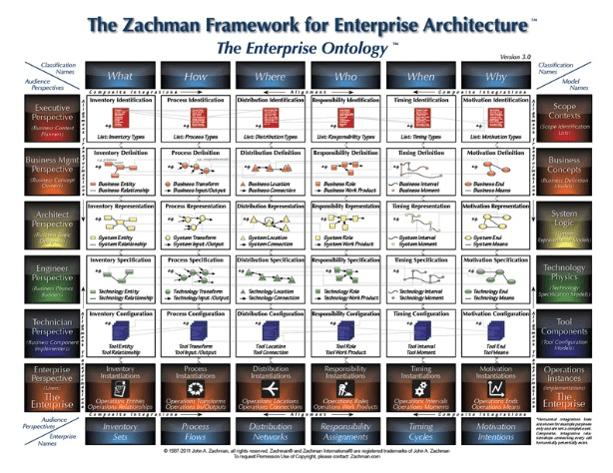 (Source: Zachman International) |
Data architects operate in alignment with the other various architecture groups
Data architects operate in alignment with the other various architecture groups, with coordination from the enterprise architect.
Enterprise Architect
The enterprise architect provides thought leadership and direction to domain architects.
They also maintain architectural standards across all the architectural domains and serve as a lead project solution architect on the most critical assignments.
- Business Architect
A business subject matter expert who works with the line-of-business team to assist in business planning through capability-based planning. - Security Architect
Plays a pivotal role in formulating the security strategy of the organization, working with the business and CISO/security manager. Recommends and maintains security standards, policies, and best practices. - Infrastructure Architect
Recommends and maintains standards across the compute, storage, and network layers of the organization. Reviews project solution architectures to ensure compliance with infrastructure standards, regulations, and target state blueprints. - Application Architect
Manages the business effectiveness, satisfaction, and maintainability of the application portfolio. Conduct application architecture assessments to document expected quality attribute standards, identify hotspots, and recommend best practices. - Data Architect
Facilitates the creation of data strategy and has a greater understanding of operational and analytical data use cases. Manages the enterprise data model which includes all the three layers of modelling - conceptual, logical, and physical. Recommends data management policies and standards, and maintains data management artefacts. Reviews project solution architectures and identifies cross impacts across the data lifecycle.
As a data architect, you must maintain balance between the technical and the business requirements
The data architect role is integral to connecting the long-term goals of the business with how the organization plans to manage its data for optimal use.
| Data architects need to have a deep experience in data management, data warehousing, and analytics technologies. At a high level, the data architect plans and implements an organization’s data, reporting, and analytics roadmap. Some of the role’s primary duties and responsibilities include:
| Data architects bridge the gap between strategic and technical requirements: “Fundamentally, the role of a data architect is to understand the data in an organization at a reasonable level of abstraction.” (Andrew Johnston, Independent Consultant) |
Info-Tech Insight
The data architect role is not always clear cut. Many organizations do not have a dedicated data architect resource, and may not need one. However, the duties and responsibilities of the data architect must be carried out to some degree by a combination of resources as appropriate to the organization’s size and environment.
Understand the role of a data architect to ensure that essential responsibilities are covered in the organization
A database administrator (DBA) is not a data architect, and data architecture is not something you buy from an enterprise application vendor.
Data Architect Role Description
Skills Necessary
|
Define Policies, Processes, and Priorities
|
See Info-Tech’s Data Architect job description for a comprehensive description of the data architect role.
Leverage data architecture frameworks to understand how the role fits into the greater Enterprise Architecture framework
Enterprise data architectures are available from industry consortiums such as The Open Group (TOGAF®), and open source initiatives such as MIKE2.0.

The Open Group TOGAF enterprise architecture model is a detailed framework of models, methods, and supporting tools to create an enterprise-level architecture.
- TOGAF was first developed in 1995 and was based on the Technical Architecture Framework for Information Management (TAFIM) developed by the US Department of Defense.
- TOGAF includes application, data, and infrastructure architecture domains providing enterprise-level, product-neutral architecture principles, policies, methods, and models.
- As a member of The Open Group, it is possible to participate in ongoing TOGAF development initiatives.
The wide adoption of TOGAF has resulted in the mapping of it to several other industry standards including CoBIT and ITIL.

MIKE2.0 (Method for an Integrated Knowledge Environment), is an open source method for enterprise information management providing a framework for information development.
- SAFE (Strategic Architecture for the Federated Enterprise) provides the technology solution framework for MIKE2.0
- SAFE includes application, presentation, information, data, Infrastructure, and metadata architecture domains.
Info-Tech Best Practice
If an enterprise-level IT architecture is your goal, TOGAF is likely a better model. However, if you are an information and knowledge-based business then MIKE2.0 may be more relevant to your business.
The data architect must identify what drives the need for data from the business to create a business-driven architecture
As the business landscape evolves, new needs arise. An organization may undergo new compliance requirements, or look to improve their customer intimacy, which could require a new functionality from an application and its associated database.
There are four common scenarios that lead to an organization’s need to optimize its data architecture and these scenarios all present unique challenges for a data architect:
- Becoming More Data Driven As organizations are looking to get more out of their data, there is a push for more accurate and timely data from applications. Data-driven decision making requires verifiable data from trustworthy sources. Result: Replace decisions made on gut or intuition with real and empirical data - make more informed and data-driven decisions.
- New Functionality or Business Rule In order to succeed as business landscapes change, organizations find themselves innovating on products or services and the way they do things. Changes in business rules, product or service offering, and new functionalities can subsequently demand more from the existing data architecture. Result: Prepare yourself to successfully launch new business initiatives with an architecture that supports business needs.
- Mergers and Acquisitions If an organization has recently acquired, been acquired, or is merging with another, the technological implications require careful planning to ensure a seamless fit. Application consolidation, retirement, data transfer, and integration points are crucial. Result: Leverage opportunities to incorporate and consolidate new synergistic assets to realize the ROI.
- Risk and Compliance Data in highly regulated organizations needs to be kept safe and secure. Architectural decisions around data impact the level of compliance within the organization. Result: Avoid the fear of data audits, regulatory violations, and privacy breaches.
Info-Tech Best Practice
These are not the only reasons why data architects need to optimize the organization’s data architecture. These are only four of the most common scenarios, however, other business needs can be addressed using the same concept as these four common scenarios.
Use the Data Architecture Driver tool to identify your focus for data architecture
Follow Info-Tech’s process of first analyzing the needs of the business, then determining how best to architect your data based on these drivers. Data architecture needs to be able to rapidly evolve to support the strategic goals of the business, and the Data Architecture Driver Pattern Identification Tool will help you to prioritize your efforts to best do this.
Tab 2. Driver Identification Objective: Objectively assess the most pressing business drivers.
|
Tab 3. Tactic Pattern Plan, Section 1 Purpose: Review your business drivers that require architectural changes in your environment.
|
Tab 3. Tactic Pattern Plan, Section 2 Purpose: Determine a list of tactics that will help you address the business drivers.
|
Step
|
Step
|
Step
|
Identify the drivers for improving your data architecture
INPUT: Data Architecture Driver tool assessment prompts.
OUTPUT: Identified business driver that applies to your organization.
Materials: Data Architecture Driver Pattern Identification Tool
Participants: Data architect, Enterprise architect
InstructionsIn Tab 2. Driver Identification of the Data Architecture Driver Pattern Identification Tool, assess the degree to which the organization is feeling the pains of the four most common business drivers:
|
Data architecture improvements need to be driven by business need.
“As a data architect, you have to understand the functional requirements, the non-functional requirements, then you need to make a solution for those requirements. There can be multiple solutions and multiple purposes.” (Andrew Johnston, Independent Consultant) |
Interview the business to get clarity on business objectives and drivers
![]() 1.1.2 1 hour per interview
1.1.2 1 hour per interview
INPUT: Sample questions targeting the activities, challenges, and opportunities of each business unit
OUTPUT: Sample questions targeting the activities, challenges, and opportunities of each business unit
Materials: Data Architecture Driver Pattern Identification Tool
Participants: Data architect, Business representatives, IT representatives
Identify 2-3 business units that demonstrate enthusiasm for or a positive outlook on improving how organizational data can help them in their role and as a unit.
Conducting a deep-dive interview process with these key stakeholders will help further identify high-level goals for the data architecture strategy within each business unit. This process will help to secure their support throughout the implementation process by giving them a sense of ownership.
Key Interview Questions:
- What are your primary activities? What do you do?
- What challenges do you have when completing your activities?
- How is poor data impacting your job?
- If [your selected domain]’s data is improved, what business issues would this help solve?
Request background information and documentation from stakeholders regarding the following:
- What current data management policies and processes exist (that you know of)?
- Who are the data owners and end users?
- Where are the data sources within the department stored?
- Who has access to these data sources?
- Are there existing or ongoing data issues within those data sources?
Interview the enterprise architect to get input on the drivers of the business
![]() 1.1.3 2 hours
1.1.3 2 hours
INPUT: Data Architecture Driver tool assessment prompts.
OUTPUT: Identified business driver that applies to your organization.
Materials: Data Architecture Driver Pattern Identification Tool
Participants: Data architect, Enterprise architect
Data architecture improvements need to be driven by business need.
| Instructions
As you work through Tab 2. Driver Identification of the Data Architecture Driver Pattern Identification Tool, consult with the enterprise architect or equivalent to assist you in rating the importance of each of the symptoms of the business drivers. This will help you provide greater value to the business and more aligned objectives. |
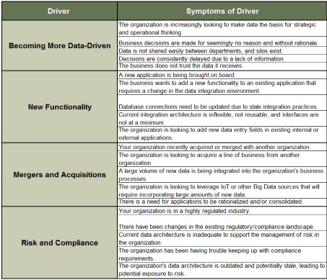 Tab 2. Driver Identification |
Once you know what that need is, go to Step 2.
Phase 1, Step 2: Establish Actionable Tactics to Optimize Data Architecture
PHASE 1 | |
| 1.1 | 1.2 |
| Identify Your Business Driver for Optimizing Data Architecture | Determine Actionable Tactics to Optimize Data Architecture |
This step will walk you through the following activities:
- Understand Info-Tech’s five-tier data architecture to begin focusing your architectural optimization.
- Create your Data Architecture Optimization Template to plan your improvement tactics.
- Prioritize your tactics based on the five-tier architecture to plan optimization.
This step involves the following participants:
- Data Architect
- Enterprise Architect
- DBAs
Outcomes of this step
- A tactical and prioritized plan for optimizing the organization’s data architecture according to the needs of the business.
To plan a business-driven architecture, data architects need to keep the organization’s big picture in mind
Remember… Architecting an organization involves alignment, planning, road mapping, design, and change management functions.
Data architects must be heavily involved with:
- Understanding the short- and long-term visions of the business to develop a vision for the organization’s data architecture.
- Creating processes for governing the identification, collection, and use of accurate and valid data, as well as for tracking data quality, completeness, and redundancy.
- They need to create strategies for data security, backup, disaster recovery, business continuity, and archiving, and ensure regulatory compliance.
To do this, you need a framework. A framework provides you with the holistic view of the organization’s data environment that you can use to design short- and long-term tactics for improving the use of data for the needs of the business.
Use Info-Tech’s five-tier data architecture to model your environment in a logical, consumable fashion.
Info-Tech Best Practice
The more complicated an environment is, the more need there is for a framework. Being able to pick a starting point and prioritize tasks is one of the most difficult, yet most essential, aspects of any architect’s role.
The five tiers of an organization’s data architecture support the use of data throughout its lifecycle
Info-Tech’s five-tier data architecture model summarizes an organization’s data environment at a logical level. Data flows from left to right, but can also flow from the presentation layer back to the warehousing layer for repatriation of data.
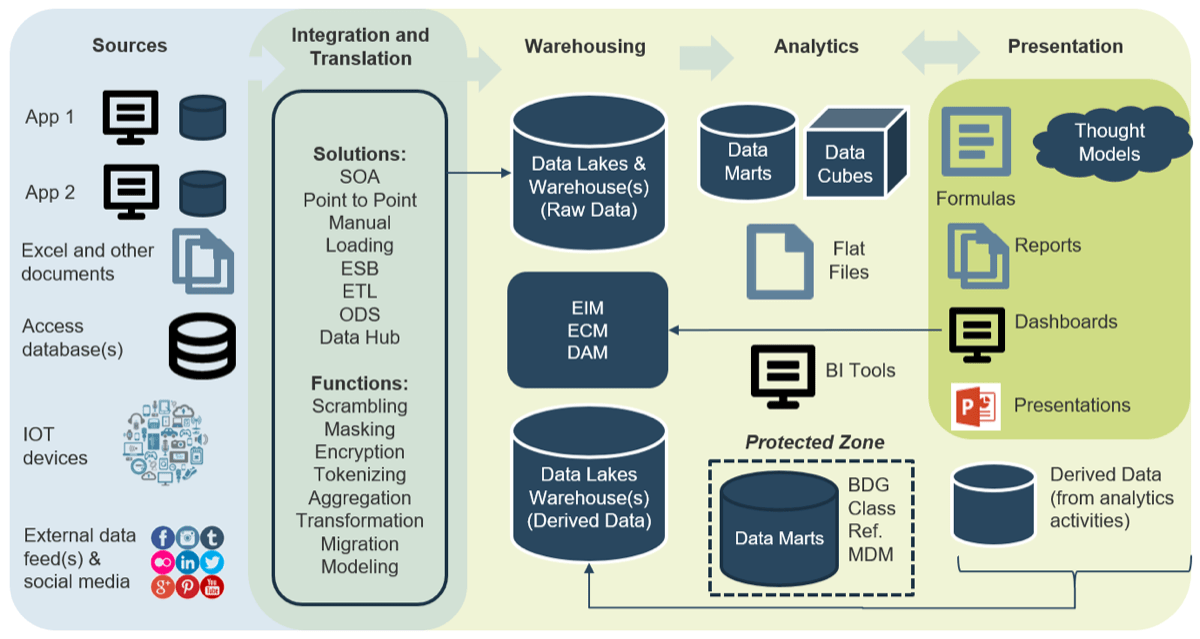
Use the Data Architecture Optimization Template to build your improvement roadmap
Download the Data Architecture Optimization Template.
Overview
Use this template to support your team in creating a tactical strategy for optimizing your data architecture across the five tiers of the organization’s architecture. This template can be used to document your organization’s most pressing business driver, the reasons for optimizing data architecture according to that driver, and the tactics that will be employed to address the shortcomings in the architecture.
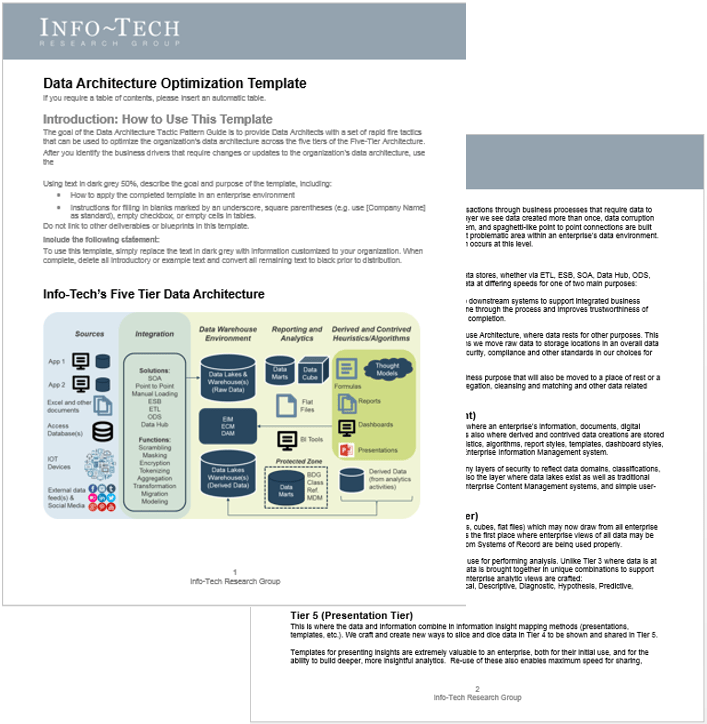 |
Info-Tech’s Data Architecture Optimization Template | Table of Contents | |
| 1. Build Your Current Data Architecture Logical Model | Use this section to document the current data architecture situation, which will provide context for your plan to optimize your data architecture. | ||
| 2. Optimization Plan | Use this section to document the tactics that will be employed to optimize the current data architecture according to the tactic pattern identified by the business driver. | ||
Fill out as you go
As you read about the details of the five-tier data architecture model in the following slides, start building your current logical data architecture model by filling out the sections that correspond to the various tiers. For example, if you identified that the most pressing business driver is becoming compliant with regulations, document the sources of data required for compliance, as well as the warehousing strategy currently being employed. This will help you to understand the organization’s data architecture at a logical level.
Tier 1 represents all of the sources of your organization’s data
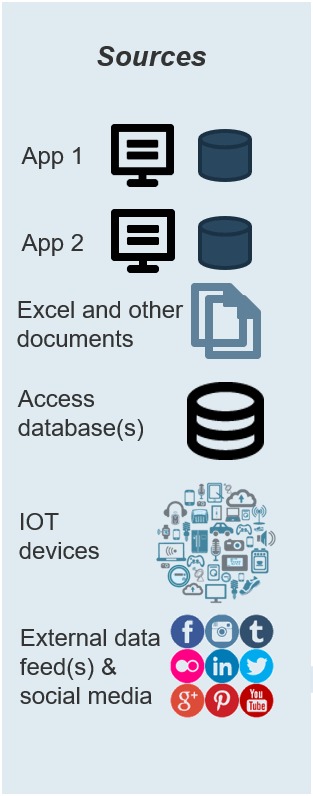 –› Data to integration layer | Tier 1 is where the data enters the organization.All applications, data documents such as MS Excel spreadsheets, documents with table entries, manual extractions from other document types, user-level databases including MS Access and MySQL, other data sources, data feeds, big datasets, etc. reside here. This tier typically holds the siloed data that is so often not available across the enterprise because the data is held within department-level applications or systems. This is also the layer where transactions and operational activities occur and where data is first created or ingested. There are any number of business activities from transactions through business processes that require data to flow from one system to another, so it is often at this layer we see data created more than once, data corruption occurs, manual re-keying of data from system to system, and spaghetti-like point-to-point connections are built that are often fragile. This is usually the single most problematic area within an enterprise’s data environment. Application- or operational-level (siloed) reporting often occurs at this level. Info-Tech Best PracticeAn optimized Tier 1 has the following attributes:
|
Tier 2 represents the movement of data
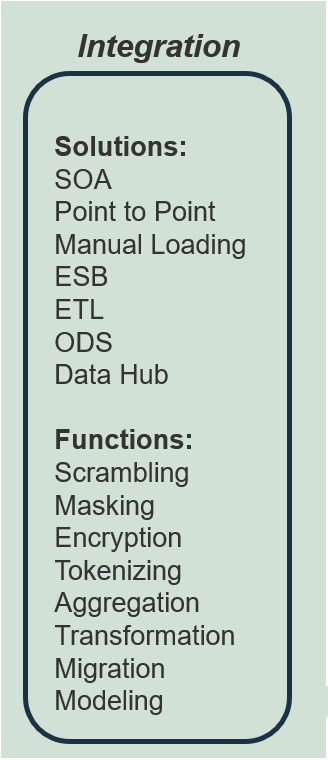 –› Data to Warehouse Environment Find out more For more information on data integration, see Info-Tech’s Optimize the Organization’s Data Integration Practices blueprint. | Tier 2 is where integration, transformation, and aggregation occur.Regardless of how you integrate your systems and data stores, whether via ETL, ESB, SOA, data hub, ODS, point-to-point, etc., the goal of this layer is to move data at differing speeds for one of two main purposes: 1) To move data from originating systems to downstream systems to support integrated business processes. This ensures the data is pristine through the process and improves trustworthiness of outcomes and speed to task and process completion. 2) To move data to Tier 3 - The Data Warehouse Architecture, where data rests for other purposes. This movement of data in its purest form means we move raw data to storage locations in an overall data warehouse environment reflecting any security, compliance and other standards in our choices for how to store. Also, this is where data is transformed for unique business purpose that will also be moved to a place of rest or a place of specific use. Data masking, scrambling, aggregation, cleansing and matching, and other data related blending tasks occur at this layer. Info-Tech Best PracticeAn optimized Tier 2 has the following attributes:
|
Tier 3 is where data comes together from all sources to be stored in a central warehouse environment
Tier 3 is where data rests in long-term storage.This is where data rests (long-term storage) and also where an enterprise’s information, documents, digital assets, and any other content types are stored. This is also where derived and contrived data creations are stored for re-use, and where formulas, thought models, heuristics, algorithms, report styles, templates, dashboard styles, and presentations-layer widgets are all stored in the enterprise information management system. At this layer there may be many technologies and many layers of security to reflect data domains, classifications, retention, compliance, and other data needs. This is also the layer where data lakes exist as well as traditional relational databases, enterprise database systems, enterprise content management systems, and simple user-level databases. Info-Tech Best PracticeAn optimized Tier 3 has the following attributes:
| Data from integration layer –›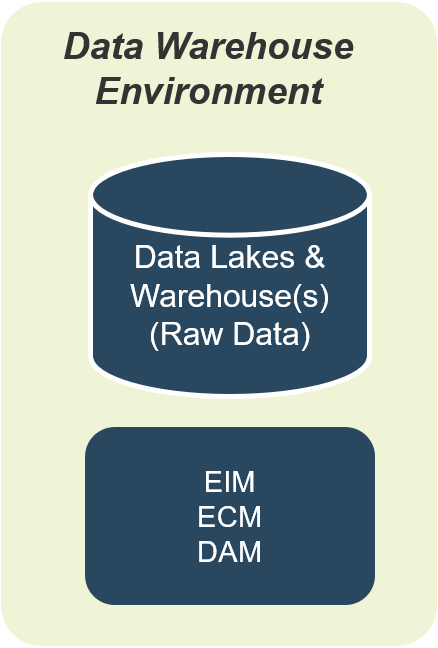 –› Analytics Find out more For more information on Data Warehousing, see Info-Tech’s Build an Extensible Data Warehouse Foundation and Drive Business Innovation With a Modernized Data Warehouse Environment blueprints. |
Tier 4 is where knowledge and insight is born
Tier 4 represents data being used for a purpose.This is where you build fit-for-purpose data sets (marts, cubes, flat files) that may now draw from all enterprise data and information sources as held in Tier 3. This is the first place where enterprise views of all data may be effectively done and with trust that golden records from systems of record are being used properly. This is also the layer where BI tools get their greatest use for performing analysis. Unlike Tier 3 where data is at rest, this tier is where data moves back into action. Data is brought together in unique combinations to support reporting, and analytics. It is here that the following enterprise analytic views are crafted:
Info-Tech Best PracticeAn optimized Tier 4 has the following attributes:
| Warehouse Environment –›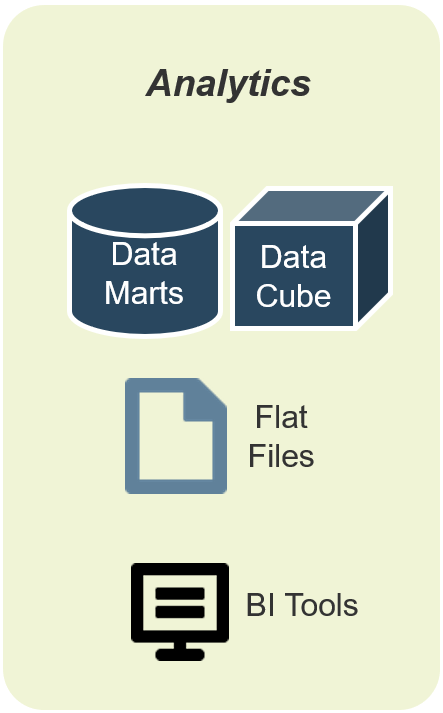 –› Presentation Find out more For more information on BI tools and strategy, see Info-Tech’s Select and Implement a Business Intelligence and Analytics Solution and Build a Next Generation BI with a Game-Changing BI Strategy blueprints. |
The presentation layer, Tier 5, is where data becomes presentable information
Tier 5 represents data in knowledge form.This is where the data and information combine in information insight mapping methods (presentations, templates, etc.). We craft and create new ways to slice and dice data in Tier 4 to be shown and shared in Tier 5. Templates for presenting insights are extremely valuable to an enterprise, both for their initial use, and for the ability to build deeper, more insightful analytics. Re-use of these also enables maximum speed for sharing, consuming the outputs, and collective understanding of these deeper meanings that is a critical asset to any enterprise. These derived datasets and the thought models, presentation styles, templates, and other derived and contrived assets should be repatriated into the derived data repositories and the enterprise information management systems respectively as shown in Tier 3. Find out more For more information on enterprise content management and metadata, see Info-Tech’s Develop an ECM Strategy and Break Open Your DAM With Intuitive Metadata blueprints. | 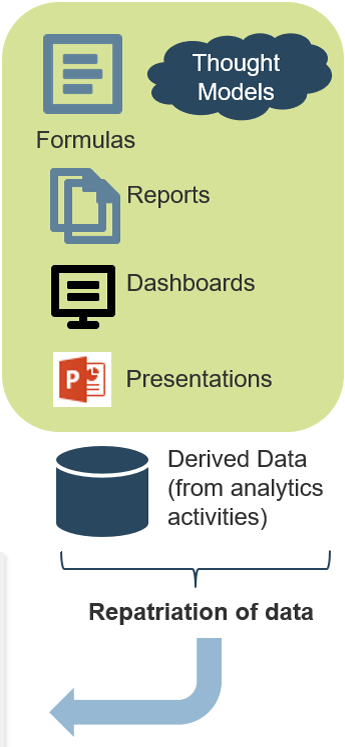 | |
Info-Tech Best PracticeAn optimized Tier 5 has the following attributes:
| Info-Tech InsightRepatriation of data and information is an essential activity for all organizations to manage organizational knowledge. This is the activity where information, knowledge, and insights that are stored in content form are moved back to the warehousing layer for long-term storage. Because of this, it is crucial to have an effective ECM strategy as well as the means to find information quickly and efficiently. This is where metadata and taxonomy come in. | |
As a data architect, you must prioritize your focus according to business need
Determine your focus.
Now that you have an understanding of the drivers requiring data architecture optimization, as well as the current data architecture situation at your organization, it is time to determine the actions that will be taken to address the driver.
1. Business driver |
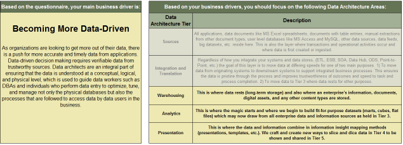 Data Architecture Driver Pattern Identification Tool, Tab 2. Tactic Pattern Plan |
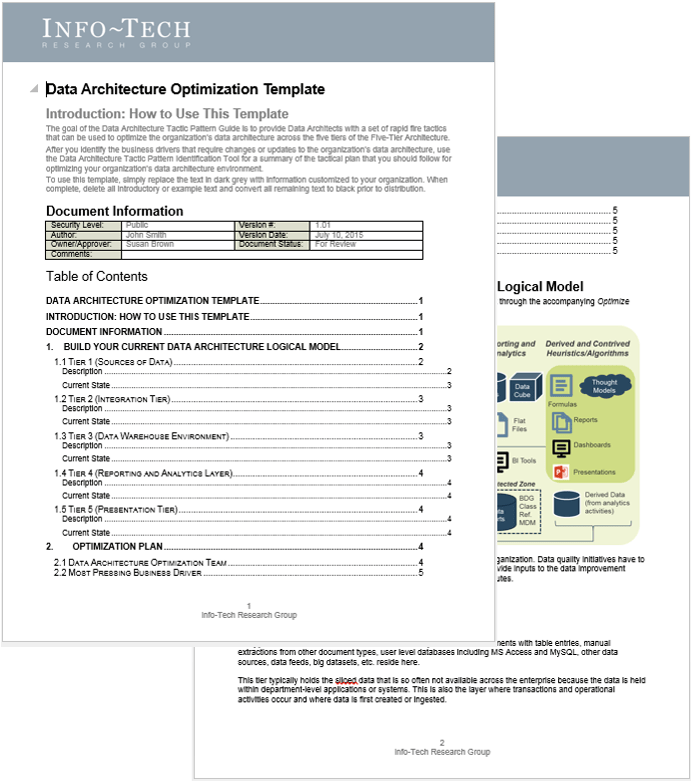 3. Documented tactic planData Architecture Optimization Template |
2. Tactics across the five tiers |
 |
The next four slides provide an overview of the priorities that accompany the four most common business drivers that require updates to a stale data architecture.
Business driver #1: Adding a new functionality to an application can have wide impacts on data architecture
Does the business wants to add a new application or supplement an existing application with a new functionality?
Whether the business wants to gain better customer intimacy, achieve operational excellence, or needs to change its compliance and reporting strategy, the need for collecting new data through a new application or a new functionality within an existing application can arise. This business driver has the following attributes:
|
 |
||
| When this business driver arises, data architects should focus on optimizing architecture at the source tier and the integration of the new functionality. | Tactics for this business driver should address the following pattern: |
||
Business driver #2: Organizations today are looking to become more data driven
Does the business wants to better leverage its data?
An organization can want to use its data for multiple reasons. Whether these reasons include improving customer experience or operational excellence, the data architect must ensure that the organization’s data aggregation environment, reporting and analytics, and presentation layer are assessed and optimized for serving the needs of the business.
“Data-drivenness is about building tools, abilities, and, most crucially, a culture that acts on data.” (Carl Anderson, Creating a Data-Driven Organization)
Tactics for this business driver should address the following pattern: |
When this business driver arises, data architects should focus on optimizing architecture at the source tier and the integration of the new functionality. | ||
 |
|
||
Business driver #3: Risk and compliance demands can put pressure on outdated architectures
Is there increasing pressure on the business to maintain compliance requirements as per regulations?
An organization can want to use its data for multiple reasons. Whether these reasons include improving customer experience or operational excellence, the data architect must ensure that the organization’s data aggregation environment, reporting and analytics, and presentation layer are assessed and optimized for serving the needs of the business.
There are different types of requirements:
|
 |
||
| When this business driver arises, data architects should focus on optimizing architecture where data is stored: at the sources, the warehouse environment, and analytics layer. | Tactics for this business driver should address the following pattern: |
||
Business driver #4: Mergers and acquisitions can require a restructuring of the organization’s data architecture
Is the organization looking to acquire or merge with another organization or line of business?There are three scenarios that encompass the mergers and acquisitions business driver for data architecture:
|
Regardless of what scenario your organization falls into, you must go through the same process of identifying the requirements for the new data:
|
|
| “As a data architect, you must do due diligence of the acquired firm. What are the workflows, what are the data sources, what data is useful, what is useless, what is the value of the data, and what are the risks of embedding the data?” (Anonymous Mergers and Acquisitions Consultant) | ||
| When this business driver arises, data architects should focus on optimizing architecture at the source tier, the warehousing layer, and analytics. |
 |
|
Determine your tier priority pattern and the tactics that you should address based on the business drivers
![]() 1.2.1 30 minutes
1.2.1 30 minutes
INPUT: Business driver assessment
OUTPUT: Tactic pattern and tactic plan
Materials: Data Architecture Driver Pattern Identification Tool, Data Architecture Optimization Template
Participants: Data architect, Enterprise architect
Instructions
|
||
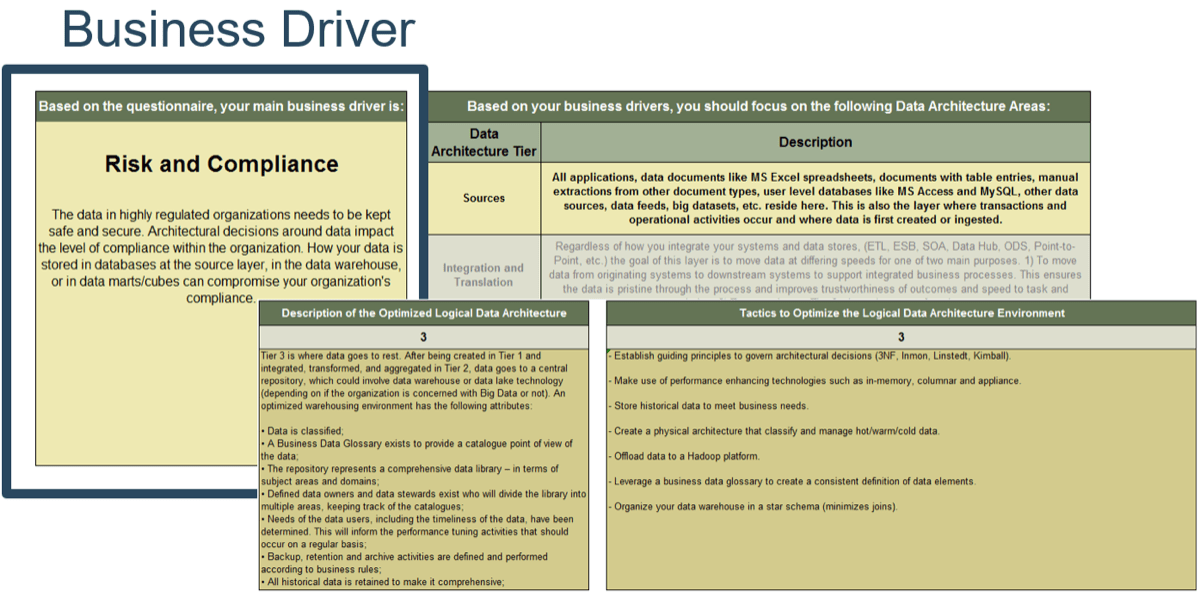 Data Architecture Driver Tool |
 |
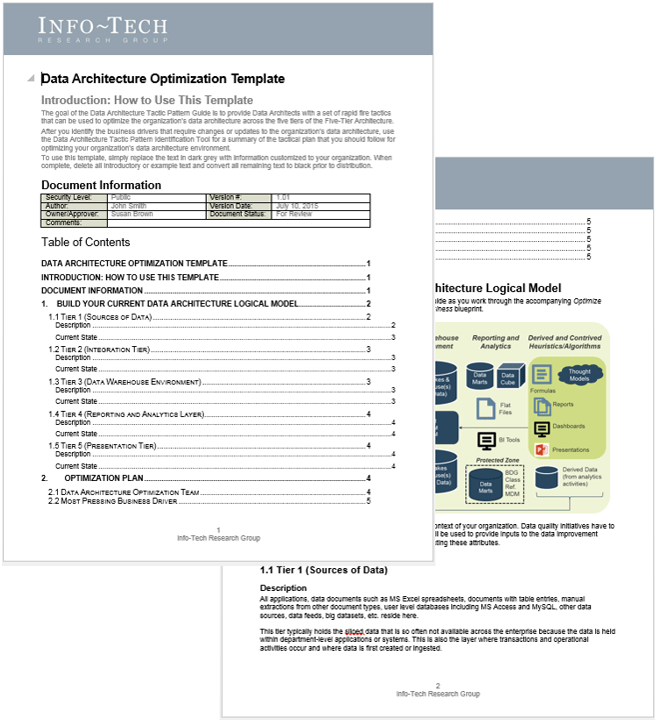 Data Architecture Optimization Template |
Info-Tech Insight
Our approach will help you to get to the solution of the organization’s data architecture problems as quickly as possible. However, keep in mind that you should still address the other tiers of your data architecture even if they are not part of the pattern we identified. For example, if you need to become more data driven, don’t completely ignore the sources and the integration of data. However, to deliver the most and quickest value, focus on tiers 3, 4, and 5.
This phase helped you to create a tactical plan to optimize your data architecture according to business priorities
Phase 1 is all about focus.
Data architects and those responsible for updating an organization’s data architecture have a wide-open playing field with which to take their efforts. Being able to narrow down your focus and generate an actionable plan will help you provide more value to the organization quickly and get the most out of your data.
- Phase 1
- Business Drivers
- Tactic Pattern
- Tactical Plan
- Tactic Pattern
Now that you have your prioritized tactical plan, move to Phase 2. This phase will help you map these priorities to the essential capabilities and measure where you stack up in these capabilities. This is an essential step in creating your data architecture roadmap and plan for coming years to modernize the organization’s data architecture.
To identify what the monetary authority needed from its data architecture, Info-Tech helped determine the business driver
CASE STUDY | Industry: Financial
|  | Part 1 |
| Prior to receiving new external requirements, the monetary Authority body had been operating with an inefficient system. Outdated legacy systems, reports in paper form, incomplete reports, and stale data from other agencies resulted in slow data access. The new requirements demanded speeding up this process.
Although the organization understood it needed changes, it first needed to establish what were the business objectives, and which areas of their architecture they would need to focus on. The business driver in this case was compliance requirements, which directed attention to the sources, aggregation, and insights tiers. |

Looking at the how the different tiers relate to certain business operations, the organization uncovered the best practise tactics to achieving an optimized data architecture.
Once the business driver had been established, the organization was able to identify the specific areas it would eventually need to evaluate and remedy as needed. |
If you want additional support, have our analysts guide you through this phase as part of an Info-Tech Workshop 
Book a workshop with our Info-Tech analysts:
 |
|
The following are sample activities that will be conducted by Info-Tech analysts with your team:
1.1.1 |
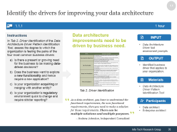 |
Identify the business driver that will set the direction of your data architecture optimization plan.
In this activity, the facilitator will guide the team in identifying the business driver that is creating the need to improve the organization’s data architecture. Data architecture needs to adapt to the changing needs of the business, so this is the most important step of any data architecture improvements. |
1.2.1 |
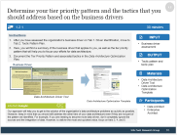 |
Determine the tactics that you will use to optimize data architecture.
In this activity, the facilitator will help the team create a tactical plan for optimizing the organization’s data architecture across the five tiers of the logical model. This plan can then be followed when addressing the business needs. |
Build a Business-Aligned Data Architecture Optimization Strategy
PHASE 2
Personalize Your Tactics to Optimize Your Data Architecture
Phase 2 will determine your tactics that you should implement to optimize your data architecture
| Business Drivers |
|
|||||||||||||||
| Tiers | 1. Data Sources | 2. Integration | 3. Warehousing | 4. Insights | 5. Presentation | |||||||||||
| Capabilities | Current Capabilities | |||||||||||||||
| Target Capabilities | ||||||||||||||||
| Example Tactics | Leverage indexes, partitions, views, and clusters to optimize performance.
Cleanse data source. |
Leverage integration technology.
Identify matching approach priorities. |
Establish governing principles.
Install performance enhancing technologies. |
Establish star schema and snowflake principles.
Share data via data mart. |
Build metadata architecture:
|
|||||||||||
Phase 2 outline
![]() Call 1-888-670-8889 or email GuidedImplementations@InfoTech.com for more information.
Call 1-888-670-8889 or email GuidedImplementations@InfoTech.com for more information.
Complete these steps on your own, or call us to complete a guided implementation. A guided implementation is a series of 2-3 advisory calls that help you execute each phase of a project. They are included in most advisory memberships.
Guided Implementation 2: Personalize Your Tactics to Optimize Your Data Architecture
Proposed Time to Completion: 2 weeks
| Step 2.1: Measure Your Data Architecture Capabilities | Step 2.2: Set a Target for Data Architecture Capabilities | Step 2.3: Identify the Tactics That Apply to Your Organization |
Start with an analyst kick-off call:
|
Review findings with analyst:
|
Finalize phase deliverable:
|
Then complete these activities…
|
Then complete these activities…
|
Then complete these activities…
|
With these tools & templates:
|
With these tools & templates:
|
With these tools & templates:
|
Phase 2 Results & Insights
|
||
Phase 2, Step 1: Measure Your Data Architecture Capabilities
PHASE 2 |
||
| 2.1 | 2.2 | 2.3 |
| Measure Your Data Architecture Capabilities | Set a Target for Data Architecture Capabilities | Identify the Tactics That Apply to Your Organization |
This step will walk you through the following activities:
- As you walk through the data architecture capability model, measure your current state in each of the relevant capabilities.
- Distinguish between essential and nice-to-have capabilities for your organization.
This step involves the following participants:
- Data Architect
Outcomes of this step
- A framework for generating a tactical plan for data architecture optimization.
- Knowledge of the various trends in the data architecture field that can be incorporated into your plan.
To personalize your tactical strategy, you must measure up your base data architecture capabilities
What is a capability?
Capabilities represent a mixture of people, technology, and processes. The focus of capability design is on the outcome and the effective use of resources to produce a differentiating capability or an essential supporting capability.
To personalize your tactics, you have to understand what the essential capabilities are across the five tiers of an organization’s data architecture. Then, assess where you currently stand in these capabilities and where you need to go in order to build your optimization plan.
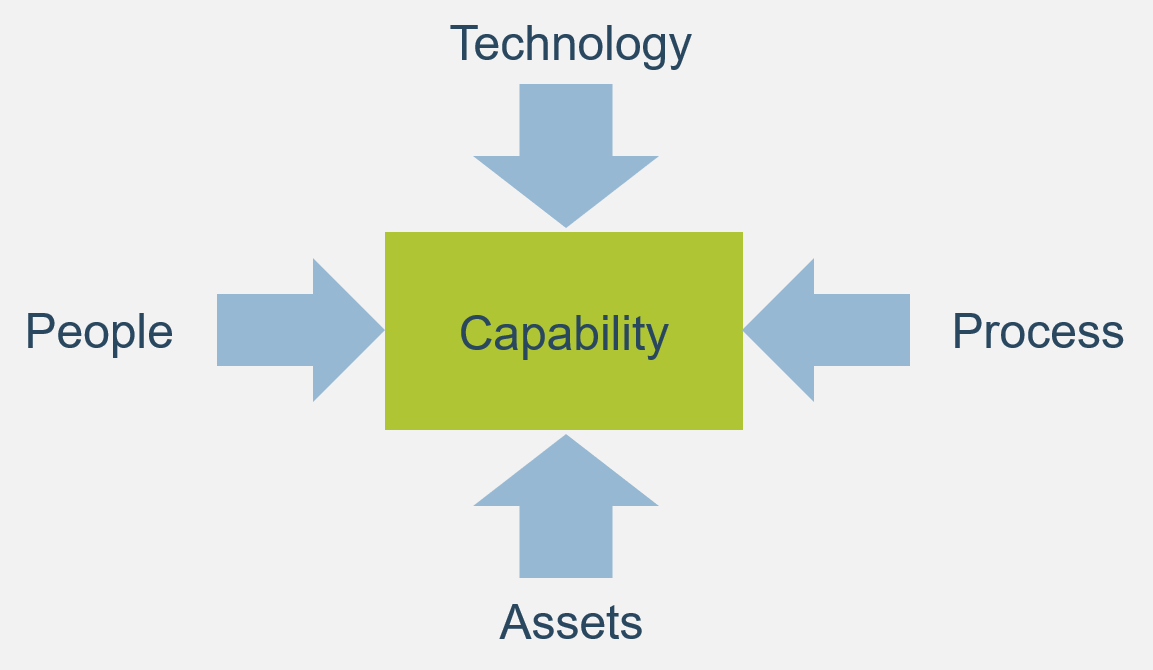
Info-Tech’s data architecture capability model can be laid over the five-tier data architecture to understand the essential and advanced capabilities that an organization should have, and to build your tactical strategy for optimizing the organization’s data architecture across the tiers.
Use Info-Tech’s data architecture capability model as a resource to assess and plan your personalized tactics
Info-Tech’s data architecture capability model can be laid over the five-tier data architecture to understand the essential and advanced capabilities that an organization should have, and to build your tactical strategy for optimizing the organization’s data architecture across the tiers.
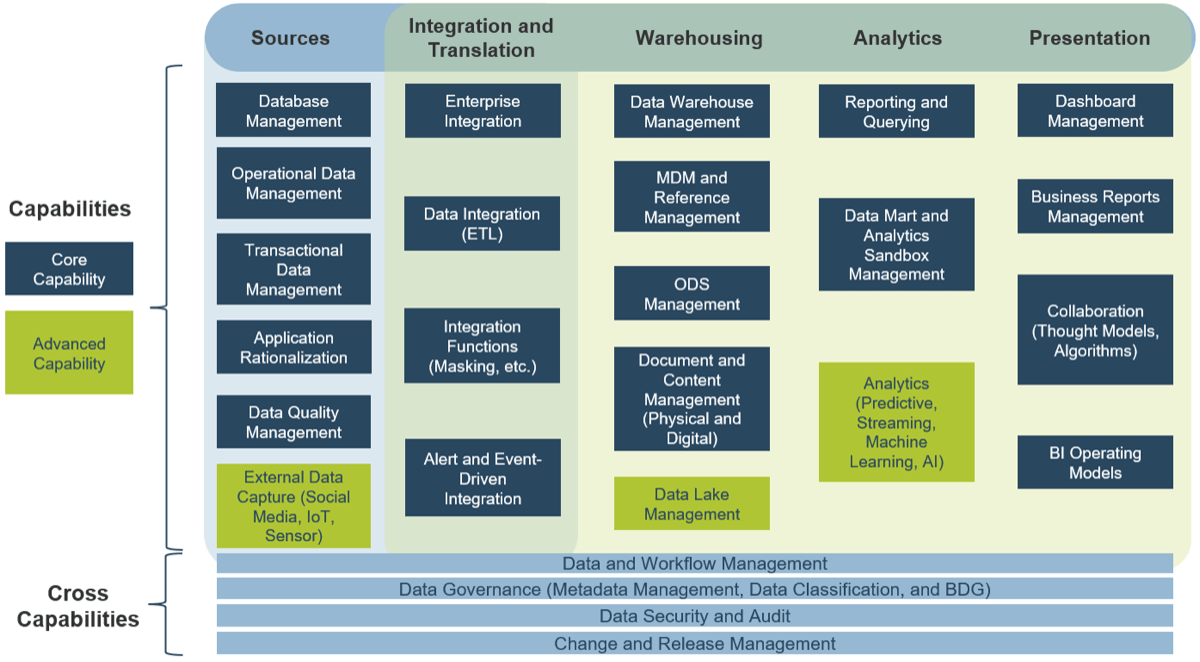
Use the Data Architecture Tactical Roadmap Tool to create a tailored plan of action
![]() 2.1.1 Data Architecture Tactical Roadmap Tool
2.1.1 Data Architecture Tactical Roadmap Tool
InstructionsUse the Data Architecture Tactical Roadmap Tool as your central tool to develop a tactical plan of action to optimize the organization’s data architecture. This tool contains the following sections:
| INFO-TECH DELIVERABLE |
Benefits of using this tool:
- Comprehensive documentation of data architecture capabilities present in leading organizations.
- Generates an accurate architecture roadmap for your organization that is developed in alignment with the broader enterprise architecture and related architectural domains.
To create a plan for your data architecture priorities, you must first understand where you currently stand
Now that you understand the business problem that you are trying to solve, it is time to take action in solving the problem.
The organization likely has some of the capabilities that are needed to solve the problem, but also a need to improve other capabilities. To narrow down the capabilities that you should focus on, first select the business driver that was identified in Phase 1 in Tab 1. Business Driver Input of the Data Architecture Tactical Roadmap Tool. This will customize the roadmap tool to deselect the capabilities that are likely to be less relevant to your organization.
For Example: If you identified your business driver as “becoming more data-driven”, you will want to focus on measuring and building out the capabilities within Tiers 3, 4, and 5 of the capability model.
Data Architecture Capability Model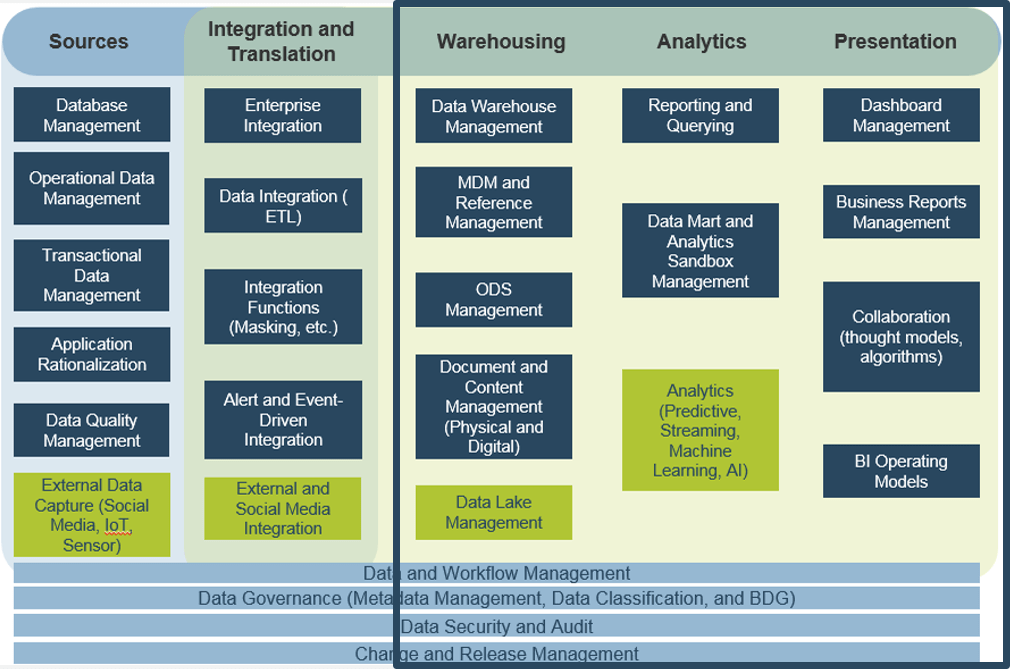 |
NoteIf you want to assess your organization for all of the capabilities across the data architecture capability model, select “Comprehensive Data Architecture Assessment” in Tab 1. Business Driver Input of the Data Architecture Tactical Roadmap Tool.
|
Determine your current state across the related architecture tiers
![]() 2.1.2 1 hour
2.1.2 1 hour
INPUT: Current data architecture capabilities.
OUTPUT: An idea of where you currently stand in the capabilities.
Materials: Data Architecture Tactical Roadmap Tool
Participants: Data architect, Enterprise architect, Business representatives
Use the Data Architecture Tactical Roadmap Tool to evaluate the baseline and target capabilities of your practice in terms of how data architecture is approached and executed.
Instructions
These results will set the baseline against which you will monitor performance progress and keep track of improvements over time. |
To assess data architecture maturity, Info-Tech uses the Capability Maturity Model Integration (CMMI) program for rating capabilities on a scale of 1 to 5:
1 = Initial/Ad hoc 2 = Developing 3 = Defined 4 = Managed and Measurable 5 = Optimized |
Info-Tech Insight
Focus on Early Alignment. Assessing capabilities within specific people’s job functions can naturally result in disagreement or debate, especially between business and IT people. Objectively facilitate any debate and only finalize capability assessments when there is full alignment. Remind everyone that data architecture should ultimately serve business needs wherever possible.
Phase 2, Step 2: Set a Target for Data Architecture Capabilities
PHASE 2 | ||
| 2.1 | 2.2 | 2.3 |
| Measure Your Data Architecture Capabilities | Set a Target for Data Architecture Capabilities | Identify the Tactics That Apply to Your Organization |
This step will walk you through the following activities:
- Determine your target state in each of the relevant capabilities.
- Distinguish between essential and nice-to-have capabilities for your organization.
This step involves the following participants:
- Data Architect
Outcomes of this step
- A holistic understanding of where the organization’s data architecture currently sits, where it needs to go, and where the biggest gaps lie.
To create a plan for your data architecture priorities, you must also understand where you need to get to in the future
Keep the goal in mind by documenting target state objectives. This will help to measure the highest priority gaps in the organization’s data architecture capabilities.
| Example driver = Becoming more data driven |  |
 |
 |
Current Capabilities |  |
Target Capabilities |
| Gaps and Priorities | ||||||
 |
||||||
Determine your future state across the relevant tiers of the data architecture capability model
INPUT: Current state of data architecture capabilities.
OUTPUT: Target state of data architecture capabilities.
Materials: Data Architecture Tactical Roadmap Tool
Participants: Data architect
The future of data architecture is now.
Determine the state of data architecture capabilities that the organization needs to reach to address the drivers of the business.
For example: If you identified your business driver as “becoming more data driven”, you will want to focus on the capabilities within Tiers 3, 4, and 5 of the capability model.
| Driver = Becoming more data driven |  |
 |
 |
Target Capabilities |
Identify where gaps in your data architecture capabilities lie
![]() 2.2.2 1 hour
2.2.2 1 hour
INPUT: Current and target states of data architecture capabilities.
OUTPUT: Holistic understanding of where you need to improve data architecture capabilities.
Materials: Data Architecture Tactical Roadmap Tool
Participants: Data architect
Visualization of gap assessment of data quality practice capabilities
To enable deeper analysis on the results of your capability assessment, Tab 4. Capability Gap Analysis in the Data Architecture Tactical Roadmap Tool creates visualizations of the gaps identified in each of your practice capabilities and related data management practices. These diagrams serve as analysis summaries.
Gap Assessment of Data Source Capabilities

Use Tab 3. Data Quality Practice Scorecard to enhance your data quality project.
- Enhance your gap analyses by forming a relative comparison of total gaps in key practice capability areas, which will help in determining priorities.
- Put these up on display to improve discussion in the gap analyses and prioritization sessions.
- Improve the clarity and flow of your strategy template, final presentations, and summary documents by copying and pasting the gap assessment diagrams.
Phase 2, Step 3: Identify the Tactics That Apply to Your Organization
PHASE 2 | ||
| 2.1 | 2.2 | 2.3 |
| Measure Your Data Architecture Capabilities | Set a Target for Data Architecture Capabilities | Identify the Tactics That Apply to Your Organization |
This step will walk you through the following activities:
- Before making your personal tactic plan, identify the trends in data architecture that can benefit your organization.
- Understand Info-Tech’s data architecture capability model.
- Initiate the Data Architecture Roadmap Tool to begin creating a roadmap for your optimization plan.
This step involves the following participants:
- Data Architect
Outcomes of this step
- A framework for generating a tactical plan for data architecture optimization.
- Knowledge of the various trends in the data architecture field that can be incorporated into your plan.
Capitalize on trends in data architecture before you determine the tactics that apply to you
Stop here. Before you begin to plan for optimization of the organization’s data environment, get a sense of the sustainability and scalability of the direction of the organization’s data architecture evolution.
Practically any trend in data architecture is driven by an attempt to solve one or more the common challenges of today’s tumultuous data landscape, otherwise known as “big data.” Data is being produced in outrageous amounts, at very high speeds, and in a growing number of types and structures.
To meet these demands, which are not slowing down, you must keep ahead of the curve. Consider the internal and external catalysts that might fuel your organization’s need to modernize its data architecture:
Big Data |
Data Storage |
Advanced analytics |
Unstructured data |
Integration |
| Hadoop ecosystem
The discussion about big data is no longer about what it is, but how do businesses of all types operationalize it. Is your organization currently capturing and leveraging big data? Are they looking to do so in the near future? |
The cloud
The cloud offers economical solutions to many aspects of data architecture. Have you dealt with issues of lack of storage space or difficulties with scalability? Do you need remote access to data and tools? |
Real-time architecture
Advanced analytics (machine learning, natural language processing) often require data in real-time. Consider Lambda and Kappa architectures. Has your data flow prevented you from automation, advanced analytics, or embracing the world of IoT? |
Graph databases
Self-service data access allows more than just technical users to participate in analytics. NoSQL can uncover buried relationships in your data. Has your organization struggled to make sense of different types of unstructured data? |
Is ETL enough?
What SQL is to NoSQL, ETL is to NoETL. Integration techniques are being created to address the high variety and high velocity of data. Have your data scientists wasted too much time and resources in the ETL stage? |
Read the Data Architecture Trends Presentation to understand the current cutting edge topics in data architecture
The speed at which new technology is changing is making it difficult for IT professionals to keep pace with best practices, let alone cutting edge technologies.
The Info-Tech Data Architecture Trends Presentation provides a glance at some of the more significant innovations in technology that are driving today’s advanced data architectures. This presentation also explains how these trends relate to either the data challenges you may be facing, or the specific business drivers you are hoping to bring to your organization. |
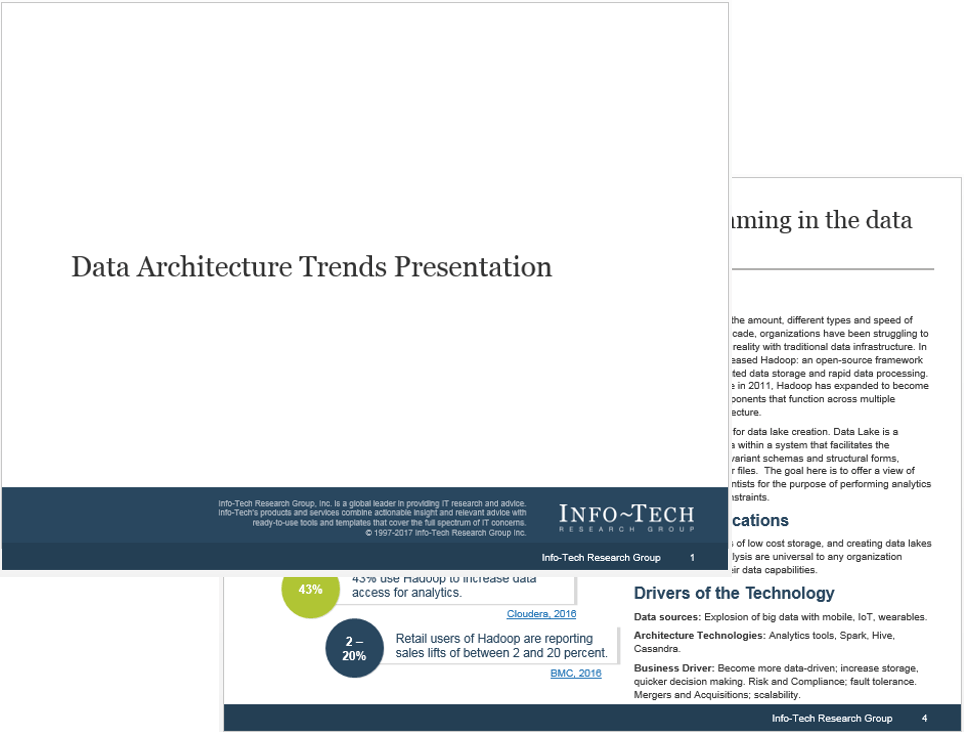 Data Architecture Trends Presentation |
Gaps between your current and future capabilities will help you to determine the tactics that apply to you
Now that you know where the organization currently stands, follow these steps to begin prioritizing the initiatives:
- What are you trying to accomplish? Determine target states that are framed in quantifiable objectives that can be clearly communicated. The more specific the objectives are the better.
- Evaluate the “delta,” or difference between where the organization currently stands and where it needs to go. This will be expressed in terms of gap closure strategies, and will help clarify the initiatives that will populate the road map.
- Determine the relative business value of each initiative, as well as the relative complexities of successfully implementing them. These scores should be created with stakeholder input, and then plotted in an effort/transition quadrant map to determine where the quickest and most valuable wins lie.
| Current State | Gap Closure Strategies | Target State | Data Architecture Tactical Roadmap |
|
Initiatives involving:
|
|
(Source: “How to Build a Roadmap”) |
Info-Tech Insight
Optimizing data architecture requires a tactical approach, not a passive approach. The demanding task of optimization requires the ability to heavily prioritize. After you have identified why, determine how using our pre-built roadmap to address the four common drivers.
Each of the layers of an organization’s data architecture have associated challenges to optimization
Stop! Before you begin, recognize these “gotchas” that can present roadblocks to creating an effective data architecture environment.
Before diving headfirst into creating your tactical data architecture plan, documenting the challenges associated with each aspect of the organization’s data architecture can help to identify where you need to focus your energy in optimizing each tier. The following table presents the common challenges across the five tiers:
Source Tier |
Integration Tier |
Warehousing Tier |
Analytics Tier |
Presentation Tier |
| Inconsistent data models | Performance issues | Scalability of the data warehouse | Data currency, flexibility | Model interoperability |
| Data quality measures: data accuracy, timeliness, accessibility, relevance | Duplicated data | Infrastructure needed to support volume of data | No business context for using the data in the correct manner | No business context for using the data in the correct manner |
| Free-form field and data values beyond data domain | Tokenization and other required data transformations | Performance
Volume Greedy consumers can cripple performance Insufficient infrastructure |
Inefficiencies in building the data mart | Report proliferation/chaos (“kitchen sink dashboards”) |
| Reporting out of source systems | DB model inefficiencies | |||
| Manual errors;
Application usability |
Elasticity |
Create metrics before you plan to optimize your data architecture
![]() 2.2.3 1 hour
2.2.3 1 hour
INPUT: Tactics that will be used to optimize data architecture.
OUTPUT: Metrics that can be used to measure optimization success.
Materials: Data Architecture Tactical Roadmap Tool
Participants: Data architect
Metrics will help you to track your optimization efforts and ensure that they are providing value to the organization.
There are two types of metrics that are useful for data architects to track and measure: program metrics and project metrics. Program metrics represent the activities that the data architecture program, which is the sum of multiple projects, should help to improve. Project metrics are the more granular metrics that track each project.
Program Metrics
|
Project Metrics
|
Use Tab 6. Metrics of the Data Architecture Tactical Roadmap Tool to document and track metrics associated with your optimization tactics.
Use Info-Tech’s resources to build your data architecture capabilities
The following resources from Info-Tech can be used to improve the capabilities that were identified as having a gap. Read more about the details of the five-tier architecture in the blueprints below:
| Data Governance
Data architecture depends on effective data governance. Use our blueprint, Enable Shared Insights With an Effective Data Governance Engine to get more out of your architecture. |
Data Quality
The key to maintaining high data quality is a proactive approach that requires you to establish and update strategies for preventing, detecting, and correcting errors. Find out more on how to improve data quality with Info-Tech’s blueprint, Restore Trust in Your Data Using a Business-Aligned Data Quality Management Approach. |
| Master Data Management
When you start your data governance program, you will quickly realize that you need an effective MDM strategy for managing your critical data assets. Use our blueprint, Develop a Master Data Management Strategy and Roadmap to Better Monetize Data to get started with MDM. |
Data Warehouse
The key to maintaining high data quality is a proactive approach that requires you to establish and update strategies for preventing, detecting, and correcting errors. Find out more on how to improve data quality with Info-Tech’s blueprint, Drive Business Innovation With a Modernized Data Warehouse Environment. |
With the optimal tactics identified, the monetary authority uncovered areas needing improvement
CASE STUDY | Industry: Financial
|  | Part 2 |
After establishing the appropriate tactics based on its business driver, the monetary authority was able to identify its shortcomings and adopt resolutions to remedy the issues.
| Best Practice Tactic | Current State | Solution | |
| Tier 1 - Data Sources | Identify data sources | Data coming from a number of locations. | Create data model for old and new systems. |
| Ensure data quality | Internal data scanned from paper and incomplete. | Data cleansing and update governance and business rules for migration to new system. | |
| External sources providing conflicting data. | |||
| Tier 3 - Data Warehousing | Data catalogue | Data aggregated incompletely. | Built proper business data glossary for searchability. |
| Indexing | Data warehouse performance sub-optimal. | Architected data warehouse for appropriate use (star schema). | |
| Tier 4 - Data Analytics | Data accessibility | Relevant data buried in warehouse. | Build data marts for access. |
| Data reduction | Accurate report building could not be performed in current storage. | Built interim solution sandbox, spin up SQL database. |
Establishing these solutions provided the organization with necessary information to build their roadmap and move towards implementing an optimized data architecture.
If you want additional support, have our analysts guide you through this phase as part of an Info-Tech Workshop 
Book a workshop with our Info-Tech analysts:
 |
|
The following are sample activities that will be conducted by Info-Tech analysts with your team:
2.1.1 – 2.2.2 |
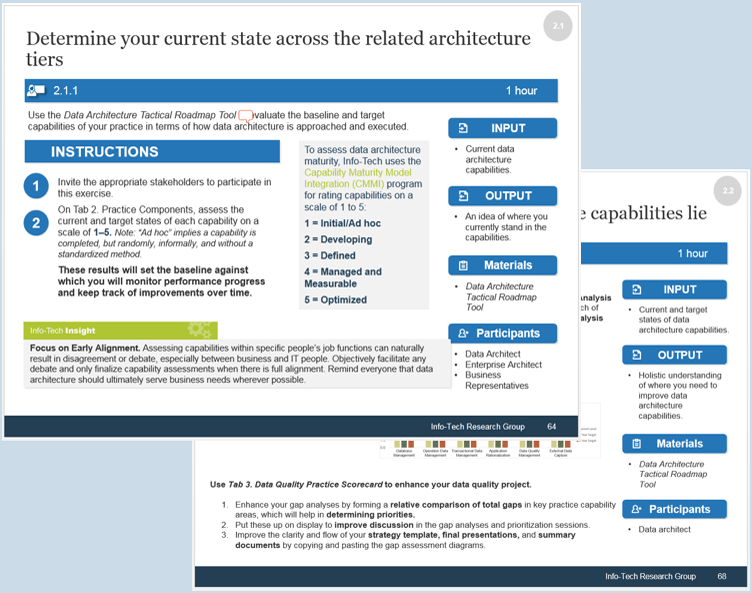 |
Evaluate your current capabilities and design your target data quality practice from two angles
In this assessment and planning activity, the team will evaluate the current and target capabilities for your data architecture’s ability to meet business needs based on the essential capabilities across the five tiers of an organization’s architectural environment. |
2.2.3 |
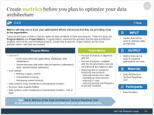 |
Create metrics to track the success of your optimization plan.
The Info-Tech facilitator will guide you through the process of creating program and project metrics to track as you optimize your data architecture. This will help to ensure that the tactics are helping to improve crucial business attributes. |
Build a Business-Aligned Data Architecture Optimization Strategy
PHASE 3
Create Your Tactical Data Architecture Roadmap
Phase 3 outline
![]() Call 1-888-670-8889 or email GuidedImplementations@InfoTech.com for more information.
Call 1-888-670-8889 or email GuidedImplementations@InfoTech.com for more information.
Complete these steps on your own, or call us to complete a guided implementation. A guided implementation is a series of 2-3 advisory calls that help you execute each phase of a project. They are included in most advisory memberships.
Guided Implementation 3: Create Your Tactical Data Architecture Roadmap
Proposed Time to Completion: 2 weeks
| Step 3.1: Personalize Your Data Architecture Roadmap | Step 3.2: Manage Your Data Architecture Decisions and the Resulting Changes |
Start with an analyst kick-off call:
| Review findings with analyst:
|
Then complete these activities…
| Then complete these activities…
|
With these tools & templates:
| With these tools & templates:
|
Phase 3 Results & Insights
| |
Phase 3, Step 1: Personalize Your Data Architecture Roadmap
PHASE 3 |
||
| 3.1 | 3.2 | |
| Personalize Your Data Architecture Roadmap | Manage Your Data Architecture Decisions and the Resulting Changes | |
This step will walk you through the following activities:
- Determine the timing, effort, and ownership of the recommended optimization initiatives.
- Brainstorm initiatives that are not yet on the roadmap but apply to you.
This step involves the following participants:
- Data Architect
- DBAs
- Enterprise Architect
Outcomes of this step
- A roadmap of specific initiatives that map to the tactical plan for optimizing your organization’s data architecture.
- A plan for communicating high-level business objectives to data workers to address the issues of the business.
Now that you have tactical priorities, identify the actionable steps that will lead you to an optimized data architecture
Phase 1 and 2 helped you to identify tactics that address some of the most common business drivers. Phase 3 will bring you through the process of practically planning what those tactics look like in your organization’s environment and create a roadmap to plan how you will generate business value through optimization of your data architecture environment.
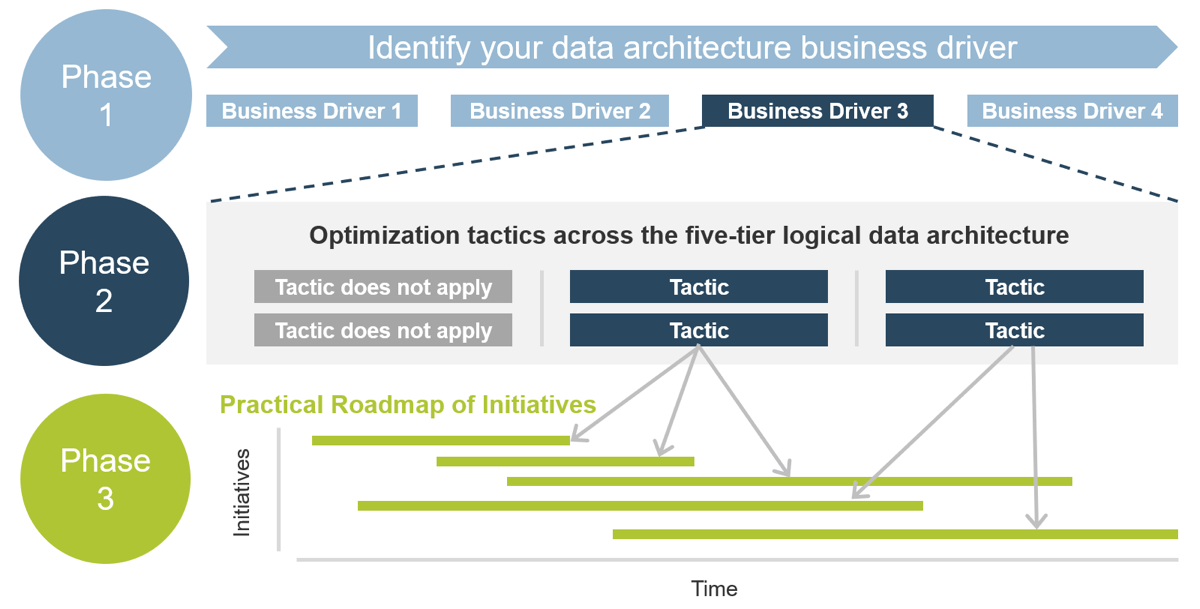
Use the Data Architecture Tactic Roadmap Tool to personalize your roadmap
Generating Your Roadmap
|
 Tab 5. Tactic and Initiative Planning
|
Determine the details of your data architecture optimization activities
![]() 3.1.2 1 hour
3.1.2 1 hour
INPUT: Timing of initiatives for optimizing data architecture.
OUTPUT: Optimization roadmap
Materials: Data Architecture Tactic Roadmap Tool
Participants: Data architect, Enterprise Architect
Instructions
- With the list of suggested activities in place on Tab 5. Tactic and Initiative Planning, select whether or not the initiatives will be included in the roadmap. By default, all of the initiatives are set to “Yes.”
- Plan the sequence, starting time, and length of each initiative, as well as the assigned responsibility of the initiative in Tab 5. Tactic and Initiative Planning of the Data Architecture Tactic Roadmap Tool.
- The tool will a generate a Gantt chart based on the start and length of your initiatives.
- The Gantt chart is generated in Tab 7. Initiative Roadmap.
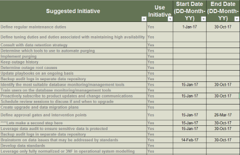 |
Tab 5. Tactic and Initiative Planning | 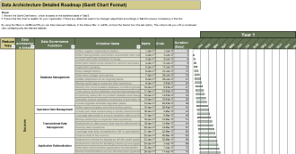 |
Tab 7. Initiative Roadmap |
Info-Tech Insight
The activities that populate the roadmap can be taken as best practice activities. If you want an actionable, comprehensive, and prescriptive plan for optimizing your data architecture, fill in the timing of the activities and print the roadmap. This can serve as a rapid communication tool for your data architecture plan to the business and other architects.
Optimizing data architecture relies on communication between the business and data workers
| Remember: Data architects bridge the gap between strategic and technical requirements of data.
|
Also remember: In Phase 1, you built your tactical data architecture optimization plan.
|
Communicate your data architecture optimization plan to the business for approval
INPUT: Data Architecture Tactical Roadmap
OUTPUT: Communication plan
Materials: Data Architecture Optimization Template
Participants: Data Architect, Business representatives, IT representatives
| Instructions
Begin by presenting your plan and roadmap to the business units who participated in business interviews in activity 1.1.3 of Phase 1. If you receive feedback that suggests that you should make revisions to the plan, consult Info-Tech Research Group for suggestions on how to improve the plan. If you gain approval for the plan, communicate it to DBAs and other data workers. |
Iterative optimization and communication plan:
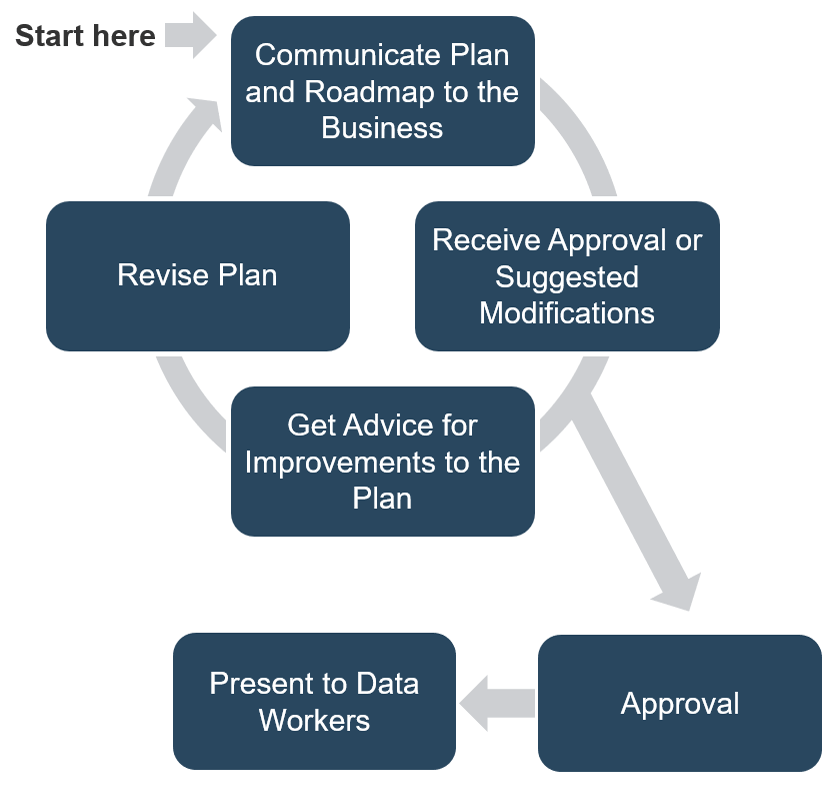 |
With a roadmap in place, the monetary authority followed a tactical and practical plan to repair outdated data architecture
CASE STUDY | Industry: Financial
|  | Part 3 |
After establishing the appropriate tactics based on its business driver, the monetary authority was able to identify its shortcomings and adopt resolutions to remedy the issues.
ChallengeA monetary authority was placed under new requirements where it would need to produce 6 different report types on its clients to a regulatory body within a window potentially as short as 1 hour. With its current capabilities, it could complete such a task in roughly 7 days. The organization’s data architecture was comprised of legacy systems that had poor searchability. Moreover, the data it worked with was scanned from paper, regularly incomplete and often inconsistent. |
SolutionThe solution first required the organization to establish the business driver behind the need to optimize its architecture. In this case, it would be compliance requirements. With Info-Tech’s methodology, the organization focused on three tiers: data sources, warehousing, and analytics. Several solutions were developed to address the appropriate lacking capabilities. Firstly, the creation of a data model for old and new systems. The implementation of governance principles and business rules for migration of any data. Additionally, proper indexing techniques and business data glossary were established. Lastly, data marts and sandboxes were designed for data accessibility and to enable a space for proper report building. |
ResultsWith the solutions established, the monetary authority was given information it needed to build a comprehensive roadmap, and is currently undergoing the implementation of the plan to ensure it will experience its desired outcome – an optimized data architecture built with the capacity to handle external compliance requirements. |
Phase 3, Step 2: Manage Your Data Architecture Decisions and the Resulting Changes
PHASE 3 | ||
| 3.1 | 3.2 | |
| Personalize Your Data Architecture Roadmap | Manage Your Data Architecture Decisions and the Resulting Changes | |
This step will walk you through the following activities:
- With a plan in place, document the major architectural decisions that have been and will be made to optimize data architecture.
- Create a plan for change and release management, an essential function of the data architect role.
This step involves the following participants:
- Data Architect
- Enterprise Architect
Outcomes of this step
- Resources for documenting and managing the inevitable change associated with updates to the organization’s data architecture environment.
To implement data architecture changes, you must plan to accommodate the issues that come with change
Once you have a plan in place, one the most challenging aspects of improving an organization is yet to come…overcoming change!
“When managing change, the job of the data architect is to avoid unnecessary change and to encapsulate necessary change.
You must provide motivation for simplifying change, making it manageable for the whole organization.” (Andrew Johnston, Independent Consultant)
 |
Create roadmap
Communicate roadmap
Implement roadmap
Change management |
Use the Data Architecture Decision Template when architectural changes are made
| Document the architectural decisions made to provide context around changes made to the organization’s data environment.
The goal of this Data Architecture Decision Template is to provide data architects with a template for managing the changes that accompany major architectural decisions. As you work through the Build a Business-Aligned Data Architecture Optimization Strategy blueprint, you will create a plan for tactical initiatives that address the drivers of the business to optimize your data architecture. This plan will bring about changes to the organization’s data architecture that need change management considerations. Document any major changes to the organization’s data architecture that are required to evolve with the organization’s drivers. This will ensure that major architectural changes are documented, tracked, and that the context around the decision is maintained. “Environment is very chaotic nowadays – legacy apps, sprawl, ERPs, a huge mix and orgs are grappling with what our data landscape look like? Where are our data assets that we need to use?” (Andrew Johnston, Independent Consultant) |
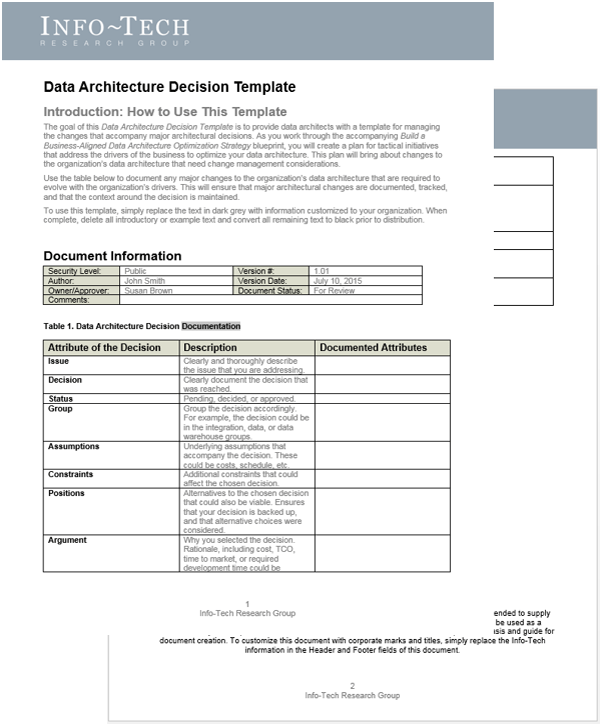
Use Info-Tech’s Data Architecture Decision Template to document any major changes in the organization’s data architecture. |
Leverage Info-Tech’s resources to smooth change management
As changes to the architectural environment occur, data architects must stay ahead of the curve and plan the change management considerations that come with major architectural decisions.
“When managing change, the job of the data architect is to avoid unnecessary change and to encapsulate necessary change.
You must provide motivation for simplifying change, making it manageable for the whole organization.” (Andrew Johnston, Independent Consultant)
See Info-Tech’s resources on change management to smooth changes: |
|
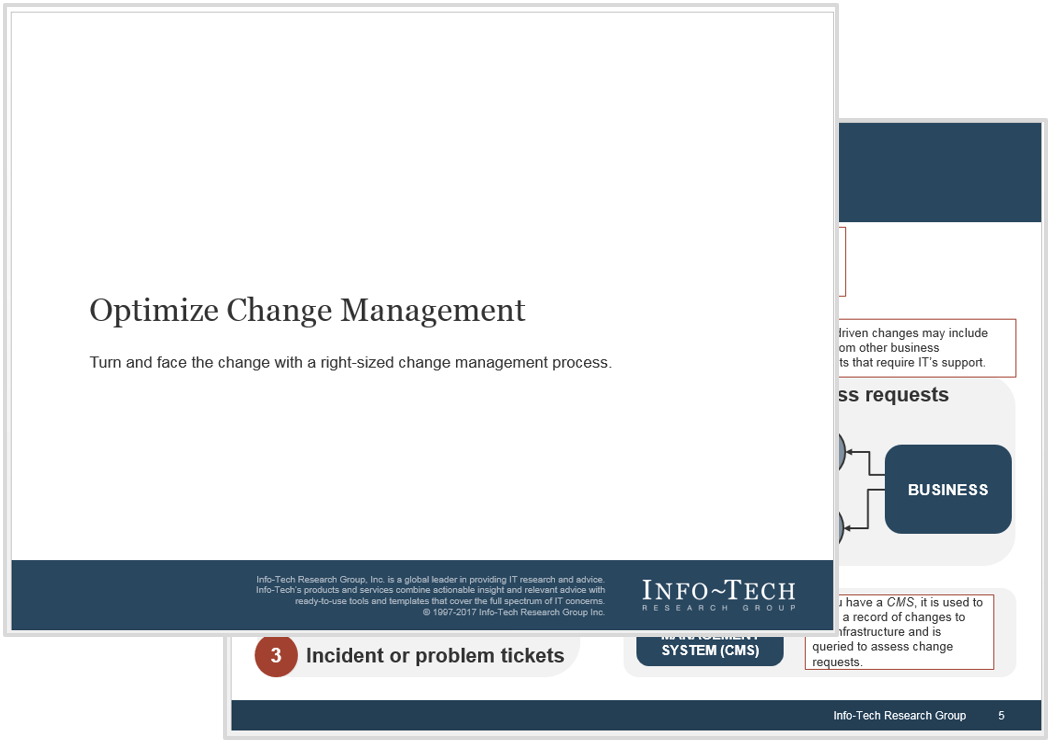
|

|
Use Info-Tech’s resources for effective release management
As changes to the architectural environment occur, data architects must stay ahead of the curve and plan the release management considerations around new hardware and software releases or updates.
Release management is a process that encompasses the planning, design, build, configuration, and testing of hardware and software releases to create a defined set of release components (ITIL). Release activities can include the distribution of the release and supporting documentation directly to end users. See Info-Tech’s resources on Release Management to smooth changes:
 |
|
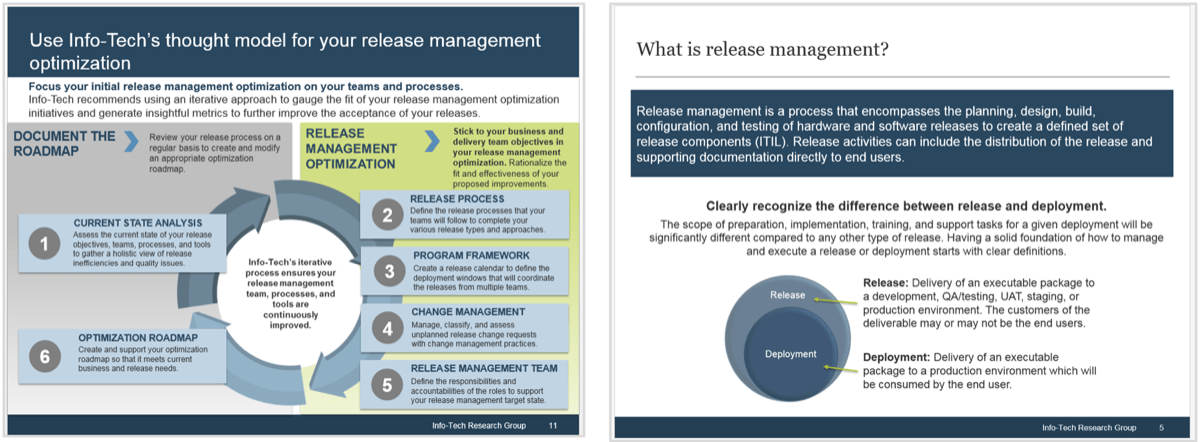
|
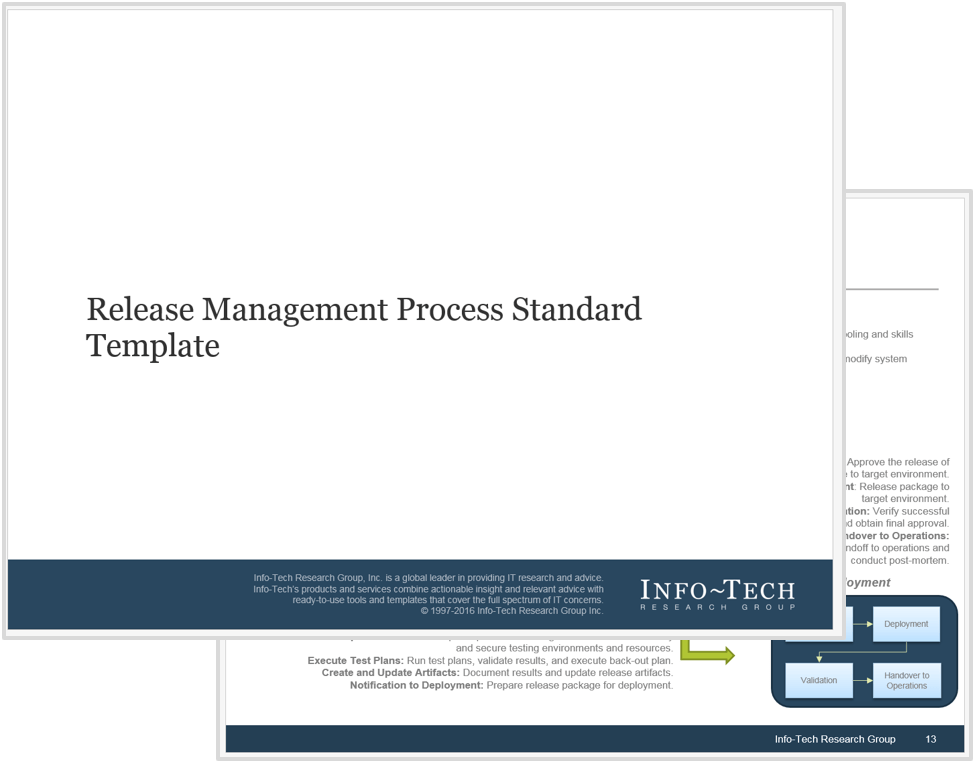
|
If you want additional support, have our analysts guide you through this phase as part of an Info-Tech Workshop 
Book a workshop with our Info-Tech analysts:
 |
|
The following are sample activities that will be conducted by Info-Tech analysts with your team:
3.1.1 |
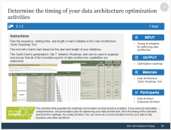 |
Create your personalized roadmap of activities.
In this activity, the facilitator will guide the team in evaluating practice gaps highlighted by the assessment, and compare these gaps at face value so general priorities can be documented. The same categories as in 3.1.1 are considered. |
3.1.3 |
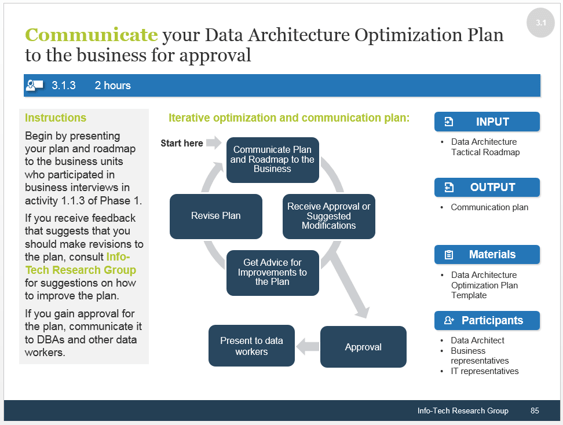 |
Communicate your data architecture optimization plan.
The facilitator will help you to identify the optimal medium and timing for communicating your plan for optimizing your data architecture. |
Insight breakdown
Insight 1
- Data architecture needs to evolve along with the changing business landscape. There are four common business drivers that put most pressure on archaic architectures. As a result, the organization’s architecture must be flexible and responsive to changing business needs.
Insight 2
- Data architecture is not just about models.
Viewing data architecture as just technical data modeling can lead to structurally unsound data that does not serve the business.
Insight 3
- Data is used differently across the layers of an organization’s data architecture, and the capabilities needed to optimize use of data change with it. Architecting and managing data from source to warehousing to presentation requires different tactics for optimal use.
Summary of accomplishment
Knowledge Gained
- An understanding of what data architecture is, how data architects can provide value to the organization, and how data architecture fits into the larger enterprise architecture picture.
- The capabilities required for optimization of the organization’s data architecture across the five tiers of the logical data architecture model.
Processes Optimized
- Prioritization and planning of data architect responsibilities across the five tiers of the five-tier logical data architecture model.
- Roadmapping of tactics that address the most common business drivers of the organization.
- Architectural change management.
Deliverables Completed
- Data Architecture Driver Pattern Identification Tool
- Data Architecture Optimization Template
- Data Architecture Trends Presentation
- Data Architecture Roadmap Tool
- Data Architecture Decision Template
Research contributors and experts
 |
Ron Huizenga, Senior Product Manager
Embarcadero Technologies, Inc. Ron Huizenga has over 30 years of experience as an IT executive and consultant in enterprise data architecture, governance, business process reengineering and improvement, program/project management, software development, and business management. His experience spans multiple industries including manufacturing, supply chain, pipelines, natural resources, retail, healthcare, insurance, and transportation. |
 |
Andrew Johnston, Architect
Independent Consultant
An independent consultant with a unique combination of managerial, commercial, and technical skills, Andrew specializes in the development of strategies and technical architectures that allow businesses to get the maximum benefit from their IT resources. He has been described by clients as a "broad spectrum" architect, summarizing his ability to engage in many problems at many levels. |
Research contributors
| Internal Contributors | |
 |
|
| External Contributors | |

  |
|
Bibliography
Allen, Mark. “Get the ETL Out of Here.” MarkLogic. Sep, 2016. Web. 25 Apr 2017.[http://www.marklogic.com/blog/get-the-etl-out-of-here/]
Anadiotis, George. “Streaming hot: Real-time big data architecture matters.” ZDNet. Jan, 2017. Web. 25 Apr 2017. [http://www.zdnet.com/article/streaming-hot-real-time-big-data-architecture-matters/]
Aston, Dan. “The Economic value of Enterprise Architecture and How to Show It.” Erwin. Aug, 2016. Web. 20 Apr 2017. [http://erwin.com/blog/economic-value-enterprise-architecture-show/]
Baer, Tony. “2017 Trends to Watch: Big Data.” Ovum. Nov, 2016. Web. 25 Apr 2017.
Bmc. “Benefits & Advantages of Hadoop.” Bmc. Web. 25 Apr 2017. [http://www.bmcsoftware.ca/guides/hadoop-benefits-business-case.html]
Boyd, Ryan, et al. “Relational vs. Graph Data Modeling” DZone. Mar 2016. Web. 25 Apr 2017. [https://dzone.com/articles/relational-vs-graph-data-modeling]
Brahmachar, Satya. “Theme To Digital Transformation - Journey to Data Driven Enterprise” Feb, 2015. Web. 20 Apr 2017. [http://satyabrahmachari-thought-leader.blogspot.ca/2015/02/i-smac-theme-to-digital-transformation.html]
Capsenta. “NoETL.” Capsenta. Web. 25 Apr 2017. [https://capsenta.com/wp-content/uploads/2015/03/Capsenta-Booklet.pdf]
Connolly, Shaun. “Implementing the Blueprint for Enterprise Hadoop” Hortonworks. Apr, 2014. Web. 25 Apr 2017. https://hortonworks.com/blog/implementing-the-blue...
Forbes. “Cloud 2.0: Companies Move From Cloud-First To Cloud-Only.” Forbes. Apr, 2017. Web. 25 Apr 2017. [https://www.forbes.com/sites/vmware/2017/04/07/cloud-2-0-companies-move-from-cloud-first-to-cloud-only/#5cd9d94a4d5e]
Forgeat, Julien. “Lambda and Kappa.” Ericsson. Nov 2015. Web 25 Apr 2017. [https://www.ericsson.com/research-blog/data-knowledge/data-processing-architectures-lambda-and-kappa/]
Grimes, Seth. “Is It Time For NoETL?” InformationWeek. Mar, 2010. Web. 25 Apr 2017. [http://www.informationweek.com/software/information-management/is-it-time-for-noetl/d/d-id/1087813]
Gupta, Manav. et al. “How IB‹ leads in building big data analytics solutions in the cloud.” IBM. Feb, 2016. Web. 25 Apr 2017. [https://www.ibm.com/developerworks/cloud/library/cl-ibm-leads-building-big-data-analytics-solutions-cloud-trs/index.html#N102DE]
“How To Build A Roadmap.” Hub Designs Magazine. Web 25 Apr 2017. [https://hubdesignsmagazine.com/2011/03/05/how-to-build-a-roadmap/]
IBM. “Top industry use cases for stream computing.” IBM. Oct, 2015. Web. 25 Apr 2017. [https://www-01.ibm.com/common/ssi/cgi-bin/ssialias?htmlfid=IMW14704USEN]
Mateos-Garcia, Juan, et al. “Skills Of The Datavores.” Nesta. July. 2015. Web. 8 Aug 2016. [https://www.nesta.org.uk/sites/default/files/skills_of_the_datavores.pdf].
Maynard, Steven. “Analytics: Don’t Forget The Human Element” Forbes. 2015. Web. 20 Apr. 2017. [http://www.ey.com/Publication/vwLUAssets/EY-Forbes-Insights-Data-and-Analytics-Impact-Index-2015/$FILE/EY-Forbes-Insights-Data-and-Analytics-Impact-Index-2015.pdf]
Neo4j. “From Relational to Neo4j.” Neo4j. Web. 25 Apr 2017. [https://neo4j.com/developer/graph-db-vs-rdbms/#_from_relational_to_graph_databases]
NoETL “NoETL.” NoETL. Web. 25 Apr 2017. [http://noetl.org/]
Nolan, Roger. “Digital Transformation: Is Your Data Management Ready?” Informatica. Jun, 2016. Web. 20 Apr 2017. [https://blogs.informatica.com/2016/06/10/digital-transformation-data-management-ready/#fbid=hmBYQgS6hnm]
OpsClarity. “2016 State of Fast Data & Streaming Applications.” OpsClarity. Web. 25 Apr 2017. [https://www.opsclarity.com/wp-content/uploads/2016/07/2016FastDataSurvey.pdf]
Oracle. “A Relational Database Overview.” Oracle. Web. 25 Apr 2017. [https://docs.oracle.com/javase/tutorial/jdbc/overview/database.html]
Ponemon Institute LLC. “Big Data Cybersecurity Analytics Research Repor.t” Cloudera. Aug, 2016. Web. 25 Apr 2017. [https://www.cloudera.com/content/dam/www/static/documents/analyst-reports/big-data-cybersecurity-analytics-research-report.pdf]
Sanchez, Jose Juan. “Data Movement Killed the BI Star.” DV Blog. May, 2016. Web. 20 Apr. 2017. [http://www.datavirtualizationblog.com/data-movement-killed-the-bi-star/]
SAS. “Hadoop; What it is and why does it matter?” SAS. Web. 25 Apr 2017. [https://www.sas.com/en_ca/insights/big-data/hadoop.html#hadoopusers]
Schumacher, Robin. “A Quick Primer on graph Databases for RDBMS Professionals.” Datastax. Jul, 2016. Web. 25 Apr 2017. [http://www.datastax.com/2016/07/quick-primer-on-graph-databases-for-rdbms-professionals]
Swoyer, Steve. “It’s the End of the Data Warehouse as We Know It.” TDWI. Jan, 2017. Web. 20 Apr. 2017. [https://upside.tdwi.org/articles/2017/01/11/end-of-the-data-warehouse-as-we-know-it.aspx]
Webber, Jim, and Ian Robinson. “The Top 5 Use Cases of Graph Databases.” Neo4j. 2015. Web. 25 Apr 2017. [http://info.neo4j.com/rs/773-GON-065/images/Neo4j_Top5_UseCases_Graph%20Databases.pdf]
Zachman Framework. [https://www.zachman.com/]
Zupan, Jane. “Survey of Big Data Decision Makers.” Attiv/o. May, 2016. Web. 20 Apr 2017. [https://www.attivio.com/blog/post/survey-big-data-decision-makers]
Buying Options
Build a Data Architecture Roadmap
Client rating
Cost Savings
Days Saved
IT Risk Management · IT Leadership & Strategy implementation · Operational Management · Service Delivery · Organizational Management · Process Improvements · ITIL, CORM, Agile · Cost Control · Business Process Analysis · Technology Development · Project Implementation · International Coordination · In & Outsourcing · Customer Care · Multilingual: Dutch, English, French, German, Japanese · Entrepreneur
Tymans Group is a brand by Gert Taeymans BV
Gert Taeymans bv
Europe: Koning Albertstraat 136, 2070 Burcht, Belgium — VAT No: BE0685.974.694 — phone: +32 (0) 468.142.754
USA: 4023 KENNETT PIKE, SUITE 751, GREENVILLE, DE 19807 — Phone: 1-917-473-8669
Copyright 2017-2022 Gert Taeymans BV
